Paul van Yperen's Blog, page 309
May 12, 2017
H.B. Irving
H.B. Irving (1870-1919) was a British stage actor and actor-manager. He was the eldest son of Sir Henry Irving. Despite his many roles on stage and in the silent cinema, Irving is now best known for A Book of Remarkable Criminals (1918), which he wrote as a legal expert.
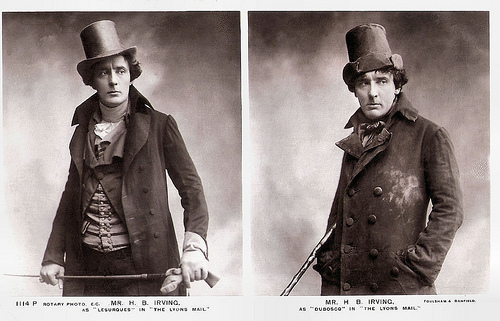
British postcard by Rotary Photo EC., no 1114 P. Photos: Foulsham and Banfield. Publicity stills of H.B. Irving as Lesurques and as Dubosq in The Lyons Mail.
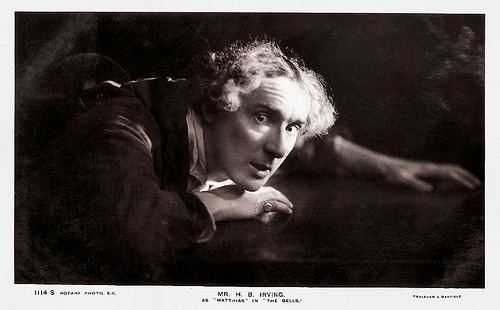
British postcard by Rotary Photo, no. 1114 S. Photo: Foulsham & Banfield. Publicity still for the stage production of The Bells (ca. 1905) with Irving as Matthias.
Barrister or actor?
Harry Brodribb Irving was born in Bayswater, London, in 1870. His parents were the famous actor Sir Henry Irving and his wife Florence née O'Callaghan.
Although, as a child, he appeared a couple of times in his father's productions, it was intended that he would become a lawyer. He attended Marlborough College and New College, Oxford where he studied law and appeared in some student productions.
At 21, he made his stage debut at the Garrick Theatre, London, in School. Afterwards, in 1894, he was called to the Bar at the Inner Temple, but instead of pursuing a career as a barrister he decided to become an actor. He took the stage name H.B. Irving to distinguish himself from his father whose birth-name he shared.
Inevitably, his early years as an actor were spent in the shadow of his father, especially as, at first, he was a member of Sir Henry Irving's Company. In 1896, he married Dorothea Baird, who, after playing the part of Trilby the year before, was, at that time, the best known actress in Britain. H.B. and Dorothea had a son Laurence, who became a well-known Hollywood art director, and a daughter Elizabeth, who would become an actress.
H.B. continued to be part of his father's company, but soon felt the need to branch out. In 1898, he joined George Alexander at the St James's Theatre where he played Don John in Much Ado About Nothing, and appeared in the surprise hit The Ambassador, a play written by Pearl Mary Teresa Craigie.
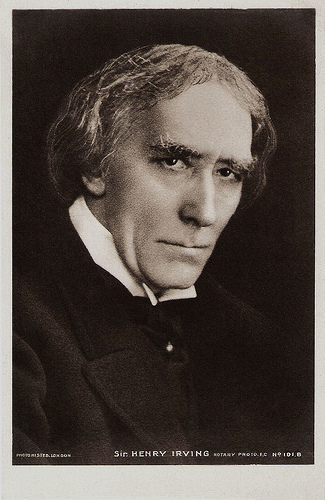
Henry Irving. British postcard by Rotary Photo, no. 101 B. Photo: Histed, London.
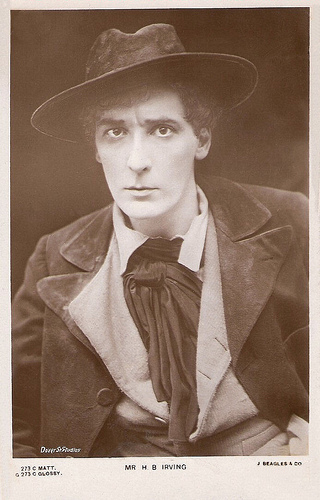
British postcard by J. Beagles & Co., London, no. G 273 C. Photo: Doyer St. Studios.
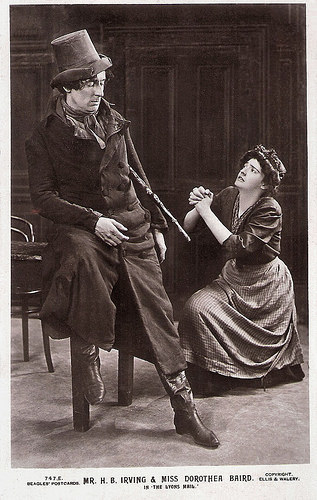
British postcard by J. Beagles & Co., London, no. 747 E. Photo: Ellis and Walery. Publicity still for the stage production of The Lyons Mail (1905) with Dorothea Baird.
Replaying his father's best remembered performances
For the following seven years, H.B. Irving and Dorothea Baird, selected the parts that appealed to them, and moved between companies, sometimes together and sometimes separately. In 1900, they both appeared in Herbert Beerbohm Tree's production of A Midsummer Night's Dream that ran for 153 performances at Her Majesty's Theatre.
In 1904, only a year before his father's death, Irving played Hamlet for the first time. The production, which was a popular success, was presented at the Adelphi Theatre.
After his father's sudden death on 13 October 1905, he established his own company, that included his wife. They toured most provincial cities, playing mainly repeats of Sir Henry Irving's best remembered performances. For the opening night of the new King's Theatre in Southsea he presented Charles I, The Bells and The Lyons Mail.
Occasionally, other plays were presented including, most successfully, Dr Jekyll and Mr Hyde at the Queen's Theatre, London. That year he gave a lecture, largely autobiographical, to the Academy of Dramatic Art in London.
In 1906 he toured with success throughout the United States, appearing in plays made memorable by his father, again The Lyons Mail, Charles I, and The Bells. In 1911, Irving, Baird and their London Company toured Australia, again presenting Hamlet.
He also started to appear in the cinema and played the leading role in the silent film Princess Clementina (William Barker, 1911). Two years later, Baird retired from the stage, while Irving kept on performing. In 1913 he visited South Africa, and a photograph records his dinner with the Owl Club in Cape Town.
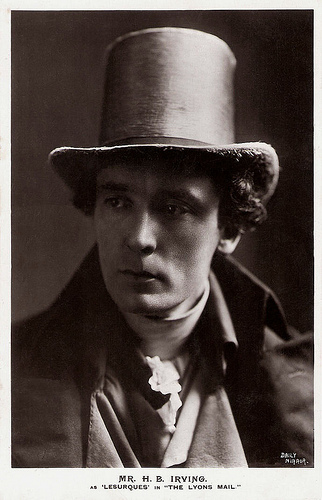
British postcard by The Daily Mirror. Photo: publicity still for the stage production of The Lyons Mail (1905).
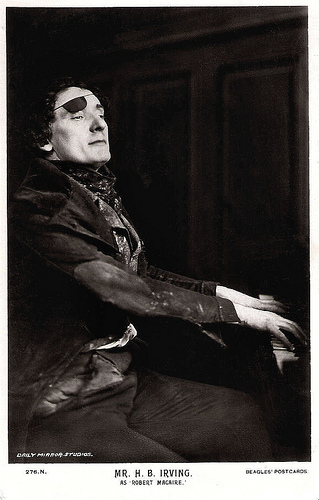
British postcard by J. Beagles & Co., no. 276 N. Photo: The Daily Mirror Studios. Photo: publicity still for the stage production of The Lyons Mail (1905) with Irving as Robert Macaire.
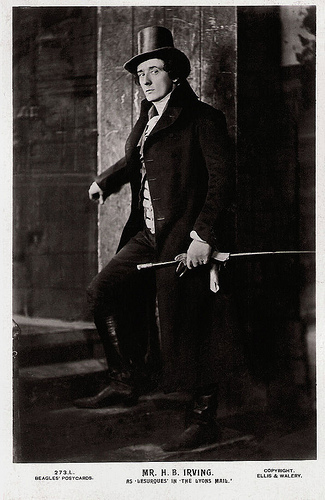
British postcard by J. Beagles & Co., no. 273 L. Photo: Ellis & Walery. Photo: publicity still for the stage production of The Lyons Mail (1905) with Irving as Lesurques.
The London Murder Club
In 1914, H.B. Irving appeared with Basil Rathbone in The Sin of David at the Savoy Theatre.
He also appeared in the British silent film The Lyons Mail (Fred Paul, 1916), based on the 1854 play The Courier of Lyons by Charles Reade, a very popular stage work of the Victorian era. A respectable French gentleman is mistaken for his doppelganger, a notorious highwaymen. It was made by the Ideal Film Company, one of the leading British silent film studios.
During World War I, H.B. Irving withdrew from the theatre and returned to the law, writing the study for which he is now most famous, A Book of Remarkable Criminals, originally published in 1918, which examined the lives, motivations and crimes of some infamous murderers, Life of Judge Jeffreys, French Criminals of the 19th Century and other papers on the subject.
Wikipedia : “After spending twenty years of his life dedicated to the theatre, his greatest success came from being what it was intended he should be, a legal expert.”
H.B. Irving was also a founding member of Our Society with a.o. Arthur Conan Doyle, Arthur Diosy, J.B. Atlay, and the Coroner Ingleby Oddie. Our Society is the still flourishing ‘Murder’ Club in London, where old crimes are discussed at regularly held dinners.
In 1919, Harry Brodribb Irving died in London. He was only 49.
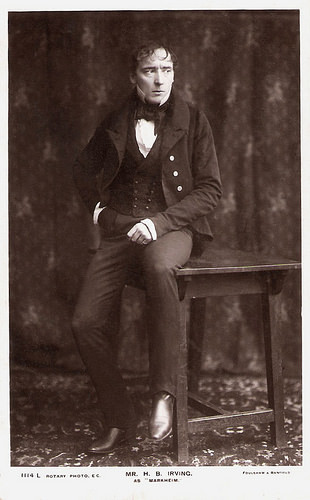
British postcard by Rotary, no. 1114 L. Photo: Foulsham and Banfield. Publicity still for the stage production of Markheim (1905) with Irving in the title role.
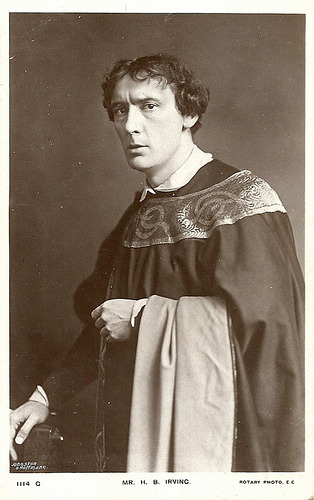
British postcard by Rotary Photo EC., no. 11. Photo: Johnston and Hoffmann.
Sources: Sydney Higgins (The Golden Age of British Theatre), Wikipedia, and .

British postcard by Rotary Photo EC., no 1114 P. Photos: Foulsham and Banfield. Publicity stills of H.B. Irving as Lesurques and as Dubosq in The Lyons Mail.

British postcard by Rotary Photo, no. 1114 S. Photo: Foulsham & Banfield. Publicity still for the stage production of The Bells (ca. 1905) with Irving as Matthias.
Barrister or actor?
Harry Brodribb Irving was born in Bayswater, London, in 1870. His parents were the famous actor Sir Henry Irving and his wife Florence née O'Callaghan.
Although, as a child, he appeared a couple of times in his father's productions, it was intended that he would become a lawyer. He attended Marlborough College and New College, Oxford where he studied law and appeared in some student productions.
At 21, he made his stage debut at the Garrick Theatre, London, in School. Afterwards, in 1894, he was called to the Bar at the Inner Temple, but instead of pursuing a career as a barrister he decided to become an actor. He took the stage name H.B. Irving to distinguish himself from his father whose birth-name he shared.
Inevitably, his early years as an actor were spent in the shadow of his father, especially as, at first, he was a member of Sir Henry Irving's Company. In 1896, he married Dorothea Baird, who, after playing the part of Trilby the year before, was, at that time, the best known actress in Britain. H.B. and Dorothea had a son Laurence, who became a well-known Hollywood art director, and a daughter Elizabeth, who would become an actress.
H.B. continued to be part of his father's company, but soon felt the need to branch out. In 1898, he joined George Alexander at the St James's Theatre where he played Don John in Much Ado About Nothing, and appeared in the surprise hit The Ambassador, a play written by Pearl Mary Teresa Craigie.

Henry Irving. British postcard by Rotary Photo, no. 101 B. Photo: Histed, London.

British postcard by J. Beagles & Co., London, no. G 273 C. Photo: Doyer St. Studios.

British postcard by J. Beagles & Co., London, no. 747 E. Photo: Ellis and Walery. Publicity still for the stage production of The Lyons Mail (1905) with Dorothea Baird.
Replaying his father's best remembered performances
For the following seven years, H.B. Irving and Dorothea Baird, selected the parts that appealed to them, and moved between companies, sometimes together and sometimes separately. In 1900, they both appeared in Herbert Beerbohm Tree's production of A Midsummer Night's Dream that ran for 153 performances at Her Majesty's Theatre.
In 1904, only a year before his father's death, Irving played Hamlet for the first time. The production, which was a popular success, was presented at the Adelphi Theatre.
After his father's sudden death on 13 October 1905, he established his own company, that included his wife. They toured most provincial cities, playing mainly repeats of Sir Henry Irving's best remembered performances. For the opening night of the new King's Theatre in Southsea he presented Charles I, The Bells and The Lyons Mail.
Occasionally, other plays were presented including, most successfully, Dr Jekyll and Mr Hyde at the Queen's Theatre, London. That year he gave a lecture, largely autobiographical, to the Academy of Dramatic Art in London.
In 1906 he toured with success throughout the United States, appearing in plays made memorable by his father, again The Lyons Mail, Charles I, and The Bells. In 1911, Irving, Baird and their London Company toured Australia, again presenting Hamlet.
He also started to appear in the cinema and played the leading role in the silent film Princess Clementina (William Barker, 1911). Two years later, Baird retired from the stage, while Irving kept on performing. In 1913 he visited South Africa, and a photograph records his dinner with the Owl Club in Cape Town.

British postcard by The Daily Mirror. Photo: publicity still for the stage production of The Lyons Mail (1905).

British postcard by J. Beagles & Co., no. 276 N. Photo: The Daily Mirror Studios. Photo: publicity still for the stage production of The Lyons Mail (1905) with Irving as Robert Macaire.

British postcard by J. Beagles & Co., no. 273 L. Photo: Ellis & Walery. Photo: publicity still for the stage production of The Lyons Mail (1905) with Irving as Lesurques.
The London Murder Club
In 1914, H.B. Irving appeared with Basil Rathbone in The Sin of David at the Savoy Theatre.
He also appeared in the British silent film The Lyons Mail (Fred Paul, 1916), based on the 1854 play The Courier of Lyons by Charles Reade, a very popular stage work of the Victorian era. A respectable French gentleman is mistaken for his doppelganger, a notorious highwaymen. It was made by the Ideal Film Company, one of the leading British silent film studios.
During World War I, H.B. Irving withdrew from the theatre and returned to the law, writing the study for which he is now most famous, A Book of Remarkable Criminals, originally published in 1918, which examined the lives, motivations and crimes of some infamous murderers, Life of Judge Jeffreys, French Criminals of the 19th Century and other papers on the subject.
Wikipedia : “After spending twenty years of his life dedicated to the theatre, his greatest success came from being what it was intended he should be, a legal expert.”
H.B. Irving was also a founding member of Our Society with a.o. Arthur Conan Doyle, Arthur Diosy, J.B. Atlay, and the Coroner Ingleby Oddie. Our Society is the still flourishing ‘Murder’ Club in London, where old crimes are discussed at regularly held dinners.
In 1919, Harry Brodribb Irving died in London. He was only 49.

British postcard by Rotary, no. 1114 L. Photo: Foulsham and Banfield. Publicity still for the stage production of Markheim (1905) with Irving in the title role.

British postcard by Rotary Photo EC., no. 11. Photo: Johnston and Hoffmann.
Sources: Sydney Higgins (The Golden Age of British Theatre), Wikipedia, and .
Published on May 12, 2017 22:00
May 11, 2017
Roger Pigaut
French actor Roger Pigaut (1919–1989) appeared in 40 films between 1943 and 1978. He also worked as a film director and scriptwriter.
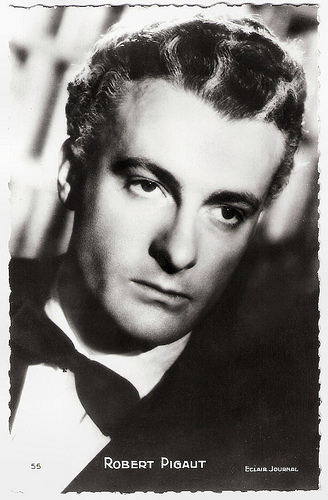
French postcard by Editions P.I., Paris, no. 55. Photo: Eclair Journal. Publicity still for L'Invité de la onzième heure/The Eleventh Hour Guest (Maurice Cloche, 1945)
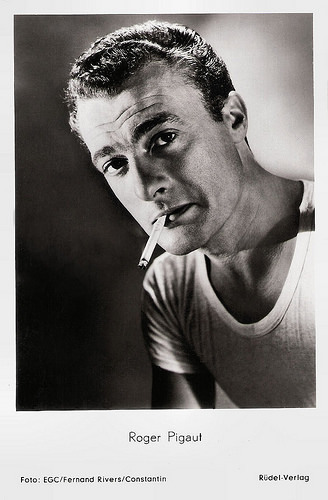
German postcard by Rüdel-Verlag, no. 1693. Photo: EGC / Fernand Rivers / Constantin Film. Publicity still for La Lumière d'en face/Female and the Flesh (Georges Lacombe, 1955).
A level of stratospheric intensity
Roger Pigaut was born Roger Paul Louis Pigot in Vincennes, France, in 1919.
In 1938, Pigaut attended the theatre courses of Raymond Rouleau and the following year he was admitted to the Conservatoire. But because of the war, he left to the South of France.
From 1943 on, he played in more than forty films. One of his first films was the romantic drama Douce/Love Story (Claude Autant-Lara, 1943) with Odette Joyeux . He co-starred with Madeleine Robinson in the crime drama Sortilèges/The Bellman (Christian-Jaque, 1945).
D.B. Dumontiel at IMDb : “Robinson and Pigaut had already teamed up in Claude Autant-Lara's classic Douce and the scenes where they are together (particularly the ball) take the film out on a level of stratospheric intensity that simply rises above the rest.”
Pigaut’s most prominent roles were as Antoine in the comedy Antoine et Antoinette (Jacques Becker, 1947) with Claire Mafféi as Antoinette, and as Pierre Bouquinquant in Les frères Bouquinquant/The brothers Bouquinquant (Louis Daquin, 1948).
D.B. Dumontiel again: “Antoine and Antoinette retains its pristine charm. It's very well acted, and Becker's camera is fluid, his sympathy for his characters is glaring. Qualities which will emerge again in such works as Rendez-vous de Juillet and his towering achievement Casque D'Or.”
Pigaut then portrayed the eighteenth century adventurer Louis Dominique Bourguignon known as Cartouche in the historical film Cartouche, roi de Paris/Cartouche (Guillaume Radot, 1950).
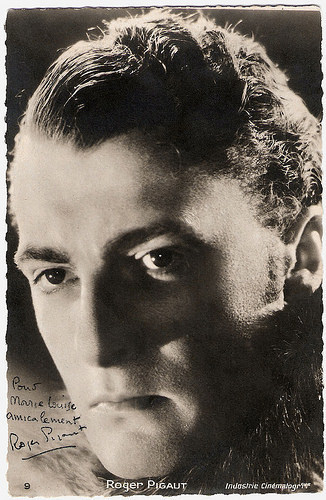
French postcard by Edit. Chantal, Rueil, no. 9. Photo: Industrie Cinématographique. Publicity still for Douce/Love Story (Claude Autant-Lara, 1943).
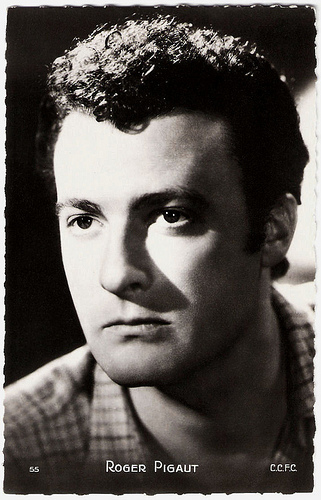
French postcard by Editions P.I., Paris, no. 55. Photo: C.C.F.C. (Compagnie Commerciale Française Cinématographique). Publicity still for Bagarres/Wench (Henri Calef, 1948).
I Killed Rasputin
In Italy, Roger Pigaut played a supporting part in the Italian Peplum Teodora, imperatrice di Bisanzio/Theodora, Slave Empress (Riccardo Freda, 1954) about Theodora ( Gianna Maria Canale ), a former slave who married Justinian I, emperor of Byzantium in AD 527–565.
He also appeared as Le Marquis d'Escrainville in two parts of the popular Angélique series featuring Michèle Mercier , Indomptable Angélique/Untamable Angelique (Bernard Borderie, 1967) and Angélique et le sultan/Angelique and the Sultan (Bernard Borderie, 1968).
Other historical films in which Pigaut appeared were the Italian-French J'ai tué Raspoutine/I Killed Rasputin (Robert Hossein, 1967) with Gert Fröbe as Grigori Rasputin, and the romantic tragedy Mayerling (Terence Young, 1968) starring Omar Sharif as Crown Prince Rudolf of Austria and Catherine Deneuve as his mistress Baroness Maria Vetsera.
His last film was Une Histoire simple/A Simple Story (Claude Sautet, 1978), starring Romy Schneider , which was nominated for the Oscar for Best Foreign Language Film.
Roger Pigaut also directed six films, and he played in the theatre. For five years, he was the companion of actress Betsy Blair from the late-1950s to the early-1960s (in between her marriages to Gene Kelly and Karel Reisz). Together with Serge Reggiani , they founded the production company Garance Films, with which they produced such films as Cerf-volant du bout du monde/The Magic of the Kite (Roger Pigaut, 1958) and the caper Trois milliards sans ascenseur/3000 Million Without an Elevator (Roger Pigaut, 1972) with Reggiani, and Dany Carrel .
Later he was married to French actress Joëlle Bernard. Roger Pigaut passed away in 1989 in Paris. He was 70.
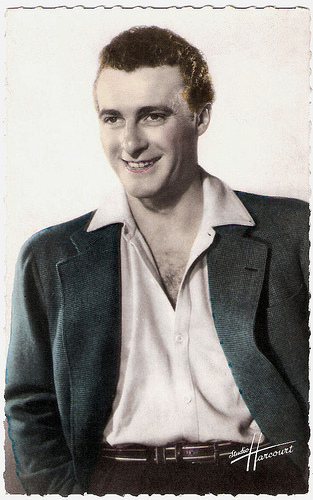
French postcard by Editions O.P., Paris, no. 36. Photo: Studio Harcourt.
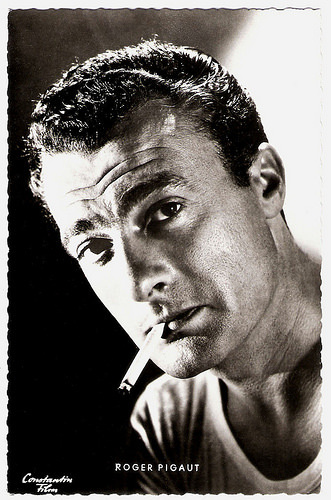
German postcard by Kunst und Bild, Berlin, no. I 477. Photo: EGC / Fernand Rivers / Constantin Film. Publicity still for La Lumière d'en face/Female and the Flesh (Georges Lacombe, 1955).
Sources: D.B. Dumonteil (IMDb), Wikipedia (French and English) and .

French postcard by Editions P.I., Paris, no. 55. Photo: Eclair Journal. Publicity still for L'Invité de la onzième heure/The Eleventh Hour Guest (Maurice Cloche, 1945)

German postcard by Rüdel-Verlag, no. 1693. Photo: EGC / Fernand Rivers / Constantin Film. Publicity still for La Lumière d'en face/Female and the Flesh (Georges Lacombe, 1955).
A level of stratospheric intensity
Roger Pigaut was born Roger Paul Louis Pigot in Vincennes, France, in 1919.
In 1938, Pigaut attended the theatre courses of Raymond Rouleau and the following year he was admitted to the Conservatoire. But because of the war, he left to the South of France.
From 1943 on, he played in more than forty films. One of his first films was the romantic drama Douce/Love Story (Claude Autant-Lara, 1943) with Odette Joyeux . He co-starred with Madeleine Robinson in the crime drama Sortilèges/The Bellman (Christian-Jaque, 1945).
D.B. Dumontiel at IMDb : “Robinson and Pigaut had already teamed up in Claude Autant-Lara's classic Douce and the scenes where they are together (particularly the ball) take the film out on a level of stratospheric intensity that simply rises above the rest.”
Pigaut’s most prominent roles were as Antoine in the comedy Antoine et Antoinette (Jacques Becker, 1947) with Claire Mafféi as Antoinette, and as Pierre Bouquinquant in Les frères Bouquinquant/The brothers Bouquinquant (Louis Daquin, 1948).
D.B. Dumontiel again: “Antoine and Antoinette retains its pristine charm. It's very well acted, and Becker's camera is fluid, his sympathy for his characters is glaring. Qualities which will emerge again in such works as Rendez-vous de Juillet and his towering achievement Casque D'Or.”
Pigaut then portrayed the eighteenth century adventurer Louis Dominique Bourguignon known as Cartouche in the historical film Cartouche, roi de Paris/Cartouche (Guillaume Radot, 1950).

French postcard by Edit. Chantal, Rueil, no. 9. Photo: Industrie Cinématographique. Publicity still for Douce/Love Story (Claude Autant-Lara, 1943).

French postcard by Editions P.I., Paris, no. 55. Photo: C.C.F.C. (Compagnie Commerciale Française Cinématographique). Publicity still for Bagarres/Wench (Henri Calef, 1948).
I Killed Rasputin
In Italy, Roger Pigaut played a supporting part in the Italian Peplum Teodora, imperatrice di Bisanzio/Theodora, Slave Empress (Riccardo Freda, 1954) about Theodora ( Gianna Maria Canale ), a former slave who married Justinian I, emperor of Byzantium in AD 527–565.
He also appeared as Le Marquis d'Escrainville in two parts of the popular Angélique series featuring Michèle Mercier , Indomptable Angélique/Untamable Angelique (Bernard Borderie, 1967) and Angélique et le sultan/Angelique and the Sultan (Bernard Borderie, 1968).
Other historical films in which Pigaut appeared were the Italian-French J'ai tué Raspoutine/I Killed Rasputin (Robert Hossein, 1967) with Gert Fröbe as Grigori Rasputin, and the romantic tragedy Mayerling (Terence Young, 1968) starring Omar Sharif as Crown Prince Rudolf of Austria and Catherine Deneuve as his mistress Baroness Maria Vetsera.
His last film was Une Histoire simple/A Simple Story (Claude Sautet, 1978), starring Romy Schneider , which was nominated for the Oscar for Best Foreign Language Film.
Roger Pigaut also directed six films, and he played in the theatre. For five years, he was the companion of actress Betsy Blair from the late-1950s to the early-1960s (in between her marriages to Gene Kelly and Karel Reisz). Together with Serge Reggiani , they founded the production company Garance Films, with which they produced such films as Cerf-volant du bout du monde/The Magic of the Kite (Roger Pigaut, 1958) and the caper Trois milliards sans ascenseur/3000 Million Without an Elevator (Roger Pigaut, 1972) with Reggiani, and Dany Carrel .
Later he was married to French actress Joëlle Bernard. Roger Pigaut passed away in 1989 in Paris. He was 70.

French postcard by Editions O.P., Paris, no. 36. Photo: Studio Harcourt.

German postcard by Kunst und Bild, Berlin, no. I 477. Photo: EGC / Fernand Rivers / Constantin Film. Publicity still for La Lumière d'en face/Female and the Flesh (Georges Lacombe, 1955).
Sources: D.B. Dumonteil (IMDb), Wikipedia (French and English) and .
Published on May 11, 2017 22:00
May 10, 2017
Ernst ist das Leben (1916)
Ernst ist das Leben/Life is Serious (1916) is a silent German film directed by American actress Fern Andra (1893-1974). Andra, who is also the the leading actress of the film, was one of the most popular film stars of the German cinema in the 1910s and early 1920s. Ernst ist das Leben was the first production of her own studio, Fern Andra-Atelier, which was situated at the roof of Chausseestraße 42 in Berlin.
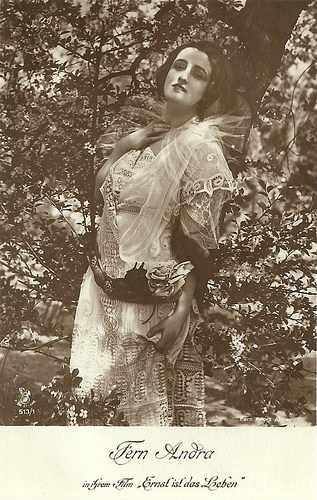
German postcard in the Film Sterne series by Rotophot, no. 513/1. Photo: Fern Andra Atelier. Publicity still from Ernst ist das Leben/Life is Serious (Fern Andra, 1916).
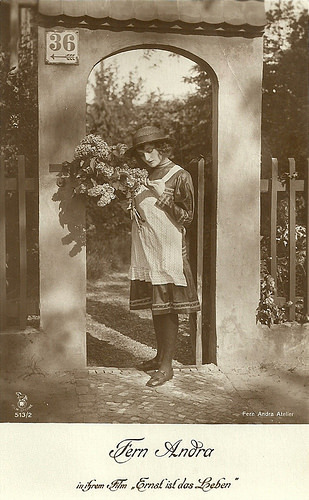
German postcard in the Film Sterne series by Rotophot, no. 513/2. Photo: Fern Andra Atelier. Publicity still from Ernst ist das Leben/Life is Serious (Fern Andra, 1916).
Death by broken heart
Ernst ist das Leben premiered on 27. October 1916 at the Berlin Tauentzienpalast cinema. The film was a typical example of Fern Andra 's melodramatic films of the 1910s, set either in aristocratic or artists milieus.
Andra plays Fanny, daughter of a flowershop seller. She is engaged with Fritz (Fritz Delius), who works at an engineering agency. But Fanny meets a ballet master who discovers her dancing talent and trains her. Fast, she makes a career as ballerina and becomes solo performer at the theatre.
When during one nighthly performance a fire breaks out, young sculptor Holger ( Alfred Abel ) saves her. Soon both get together more closely than her fiance can permit. Holger wants Fanny to model for him, but Fritz opposes.
Fanny breaks up with Fritz and marries Holger, but the marriage proves to be unhappy, as Holger goes out with other women while Fanny suffers. One night she catches him red-handed and still she tries to save her marriage, but Holger rejects her. She dies of a broken heart, in front of his sculpture.
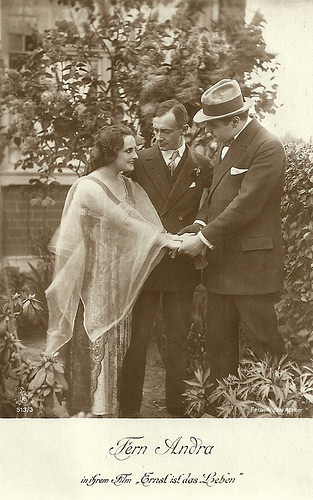
German postcard in the Film Sterne series by Rotophot, no. 513/3. Photo: Fern Andra Atelier. Publicity still from Ernst ist das Leben/Life is Serious (Fern Andra, 1916) with in the middle Alfred Abel and right Fritz Delius.
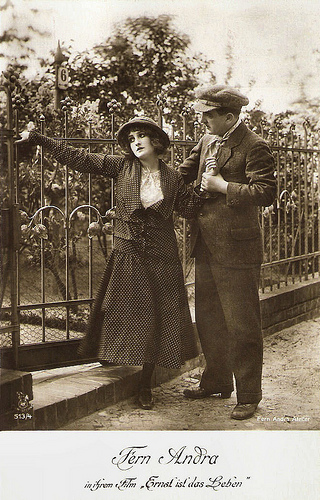
German postcard by Rotophot in the Film Sterne series, no. 513/4. Photo: Fern Andra Atelier. Still from Ernst ist das Leben/Life is Serious (Fern Andra, 1916) with Fritz Delius. This card was sent to us by Gill (Many thanks!).
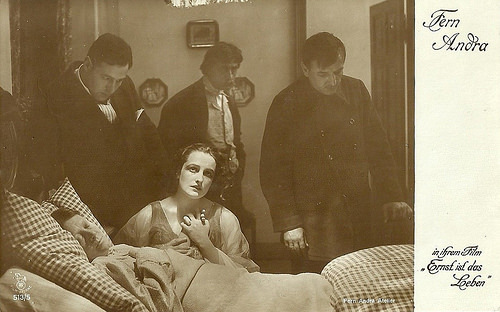
German postcard in the Film Sterne series by Rotophot, no. 513/5. Photo: Fern Andra Atelier. Publicity still from Ernst ist das Leben/Life is Serious (Fern Andra, 1916). The man on the left of Fern Andra is Fritz Delius. The dying woman in the bed is Frida Richard, who plays Andra's mother in the film.
Sources: The German Early Cinema Database, Wikipedia (German) and IMDb.

German postcard in the Film Sterne series by Rotophot, no. 513/1. Photo: Fern Andra Atelier. Publicity still from Ernst ist das Leben/Life is Serious (Fern Andra, 1916).

German postcard in the Film Sterne series by Rotophot, no. 513/2. Photo: Fern Andra Atelier. Publicity still from Ernst ist das Leben/Life is Serious (Fern Andra, 1916).
Death by broken heart
Ernst ist das Leben premiered on 27. October 1916 at the Berlin Tauentzienpalast cinema. The film was a typical example of Fern Andra 's melodramatic films of the 1910s, set either in aristocratic or artists milieus.
Andra plays Fanny, daughter of a flowershop seller. She is engaged with Fritz (Fritz Delius), who works at an engineering agency. But Fanny meets a ballet master who discovers her dancing talent and trains her. Fast, she makes a career as ballerina and becomes solo performer at the theatre.
When during one nighthly performance a fire breaks out, young sculptor Holger ( Alfred Abel ) saves her. Soon both get together more closely than her fiance can permit. Holger wants Fanny to model for him, but Fritz opposes.
Fanny breaks up with Fritz and marries Holger, but the marriage proves to be unhappy, as Holger goes out with other women while Fanny suffers. One night she catches him red-handed and still she tries to save her marriage, but Holger rejects her. She dies of a broken heart, in front of his sculpture.

German postcard in the Film Sterne series by Rotophot, no. 513/3. Photo: Fern Andra Atelier. Publicity still from Ernst ist das Leben/Life is Serious (Fern Andra, 1916) with in the middle Alfred Abel and right Fritz Delius.

German postcard by Rotophot in the Film Sterne series, no. 513/4. Photo: Fern Andra Atelier. Still from Ernst ist das Leben/Life is Serious (Fern Andra, 1916) with Fritz Delius. This card was sent to us by Gill (Many thanks!).

German postcard in the Film Sterne series by Rotophot, no. 513/5. Photo: Fern Andra Atelier. Publicity still from Ernst ist das Leben/Life is Serious (Fern Andra, 1916). The man on the left of Fern Andra is Fritz Delius. The dying woman in the bed is Frida Richard, who plays Andra's mother in the film.
Sources: The German Early Cinema Database, Wikipedia (German) and IMDb.
Published on May 10, 2017 22:00
May 9, 2017
Jeremy Irons
Tall and elegant British actor Jeremy Irons (1948) made his name in the classic TV series Brideshead Revisited (1981) and thought provoking films such as David Cronenberg's Dead Ringers (1988) and Reversal of Fortune (1990). He became a major Hollywood star with blockbusters such as Disney's The Lion King (1994), Die Hard with a Vengeance (1995) and Kingdom of Heaven (2005).
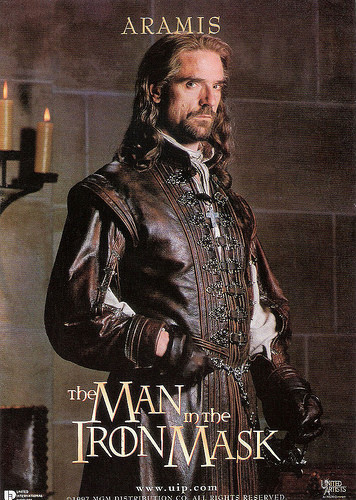
British postcard by Boomerang Media. Photo: publicity still for The Man in the Iron Mask (Randall Wallace, 1998).
Much in demand as a romantic leading man
Jeremy John Irons was born in 1948 in Cowes, Isle of Wight, a small island just off the south coast of England. He is the son of Barbara Anne Brereton (Sharpe) and Paul Dugan Irons, an accountant.
Young Jeremy didn't prove very fond of figures. A typical islander, he used to go to mainland England only once a year. He wound up being grounded when his family settled down in Hertfordshire. At the age of 13 he enrolled in Sherborne School, Dorset, where he was happy as he could practise his favourite sport, horse-riding.
Before becoming an actor, he had considered a veterinarian surgeon's career. He trained at the Bristol Old Vic School for two years. In 1969, he joined Bristol Old Vic repertory company where he gained much experience working in everything from Shakespeare to contemporary dramas. He moved to London in 1971 and had a number of odd jobs before landing the roles of John the Baptist and Judas opposite David Essex in the hit musical Godspell (1971).
He went on to a successful early career in the West End theatre and on TV, including an adaptation of H.E. Bates' novel Love for Lydia (1977). He debuted on-screen as dancer Mikhail Fokine in the biographical film Nijinsky (Herbert Ross, 1980).
In the early 1980s, he gained international attention with his starring role as the lovelorn Charles Ryder in the TV adaptation of Evelyn Waugh's classic novel Brideshead Revisited (Charles Sturridge, Michael Lindsay-Hogg, 1981), after which he was much in demand as a romantic leading man.
Irons' first major film role came in the romantic drama The French Lieutenant's Woman (Karel Reisz, 1981), for which he received a BAFTA nomination for Best Actor. He was described as 'the thinking woman's pin up', for his lean good looks, air of faintly brooding melancholy and eloquent articulation.
In spite of all this, Irons proved to be a considerable actor in dramas such as Moonlighting (Jerzy Skolimowski, 1982), Betrayal (David Jones, 1983) with Ben Kingsley, and Cannes Palme d'Or winner The Mission (Roland Joffé, 1986) opposite Robert De Niro .
In 1984, he made his Broadway debut opposite Glenn Close in Tom Stoppard's The Real Thing for which he won Broadway's 1984 Tony Award as Best Actor. In the mid-1980s, he also appeared in three lead roles with the Royal Shakespeare Company.
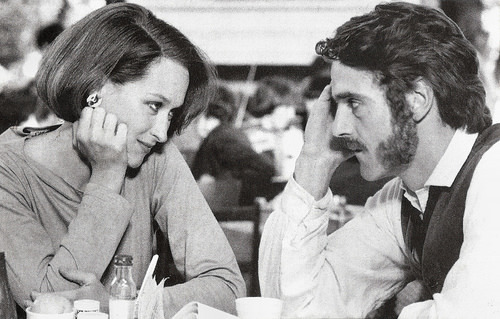
British postcard. Photo: publicity still for The French Lieutenant's Woman (Karel Reisz, 1981) with Meryl Streep.
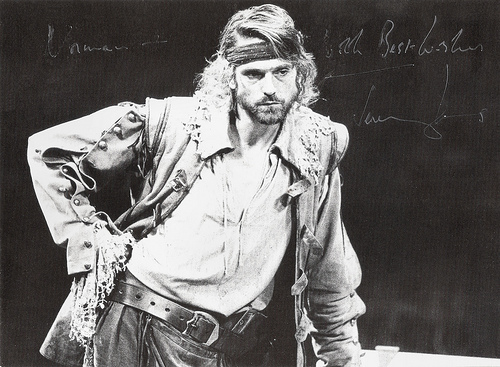
British postcard by Royal Shakespeare Company, no. 237. Photo: Donald Cooper. Publicity still for the stage production of The Rover (1986) at the Swann Theatre in Stratford-upon-Avon.
Insane twin gynaecologists
Jeremy Irons made his name with his portrayal in the dual role of insane twin gynaecologists in the thought provoking Dead Ringers (David Cronenberg, 1988), for which he won the New York Critics Best Actor Award. He then gained a Golden Globe Award in addition to an Oscar for Best Actor in 1990 for his role as Claus von Bulow in Reversal of Fortune (Barbet Schroeder, 1990) alongside Glenn Close.
In the West End, he played Professor Higgins in Loewe-Lerner's famous musical My Fair Lady in 1987. He married actress Sinéad Cusack, with whom he appeared in Waterland (1992) and in the Royal Shakespeare Company plays. He appeared with his son Samuel Irons and his father-in-law Cyril Cusack in Danny the Champion of the World (Gavin Millar, 1989), based on the 1975 novel of the same name by Roald Dahl.
Other notable films included the mystery thriller Kafka (Steven Soderbergh, 1991), the British/French film Damage (Louis Malle, 1992) with Juliette Binoche, The House of the Spirits (Bille August, 1993) based on the novel by Isabel Allende, and the romantic drama M. Butterfly (David Cronenberg, 1993).
His was the voice of Scar in Disney's animated epic musical The Lion King (Roger Allers, Rob Minkoff, 1994). Irons played Simon Gruber, the obligatory well-spoken Brit villain in the action film Die Hard with a Vengeance (John McTiernan, 1995), the third in the Die Hard film series starring Bruce Willis and the highest-grossing film at the worldwide box-office that year.
Later followed Bernardo Bertolucci's Stealing Beauty (1996), the American-French remake Lolita (Adrian Lyne, 1997) - the second screen adaptation of Vladimir Nabokov's classic novel, Musketeer Aramis in The Man in the Iron Mask (Randall Wallace, 1998) with Leonardo DiCaprio, and the poorly received American-Czech fantasy film Dungeons & Dragons (Courtney Solomon, 2000).
He co-starred with Al Pacino in The Merchant of Venice (2004), based on William Shakespeare's play of the same name. In the comedy-drama Being Julia (István Szabó, 2004), he co-starred with Annette Bening. In 2005, he won an Emmy award for Outstanding Supporting Actor in a Miniseries or a Movie for Elizabeth I (Tom Hooper, 2005), featuring Helen Mirren.
An international success was the epic historical drama Kingdom of Heaven (Ridley Scott, 2005), set during the Crusades of the 12th century. Other films include the British-American action-fantasy Eragon (Stefen Fangmeier, 2006), the Western Appaloosa (Ed Harris, 2008) with Viggo Mortensen, and the indie drama Margin Call (J.C. Chandor, 2011).
Last year, he appeared in Assassin's Creed (Justin Kurzel, 2016) with Michael Fassbender and, starting that year, he plays Alfred Pennyworth in the DC Extended Universe, beginning with Batman v Superman: Dawn of Justice (Zack Snyder, 2016) starring Ben Affleck and Henry Cavill, and later reprising the role in Justice League (Zack Snyder, 2017) and The Batman (Matt Reeves, 2018).
Jeremy Irons married twice. His first marriage in 1969 to actress Julie Hallam was soon annulled. With his second wife Sinéad Cusack he has two sons, Samuel Irons (1978), who works as a photographer, and Max Irons (1985), who is also an actor.
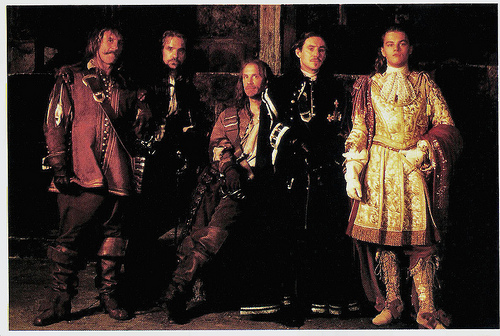
British postcard by London Postcard Company, no. MG 2001. Photo: United Artists. Publicity still for The Man in the Iron Mask (Randall Wallace, 1998) with Gérard Depardieu , Jeremy Irons, John Malkovich, Gabriel Byrne and Leonardo DiCaprio.
Trailer Damage (1992). Source: Warnerarchive (YouTube).
Sources: (IMDb), Brian McFarlane (Encyclopedia of British Film), Wikipedia and .

British postcard by Boomerang Media. Photo: publicity still for The Man in the Iron Mask (Randall Wallace, 1998).
Much in demand as a romantic leading man
Jeremy John Irons was born in 1948 in Cowes, Isle of Wight, a small island just off the south coast of England. He is the son of Barbara Anne Brereton (Sharpe) and Paul Dugan Irons, an accountant.
Young Jeremy didn't prove very fond of figures. A typical islander, he used to go to mainland England only once a year. He wound up being grounded when his family settled down in Hertfordshire. At the age of 13 he enrolled in Sherborne School, Dorset, where he was happy as he could practise his favourite sport, horse-riding.
Before becoming an actor, he had considered a veterinarian surgeon's career. He trained at the Bristol Old Vic School for two years. In 1969, he joined Bristol Old Vic repertory company where he gained much experience working in everything from Shakespeare to contemporary dramas. He moved to London in 1971 and had a number of odd jobs before landing the roles of John the Baptist and Judas opposite David Essex in the hit musical Godspell (1971).
He went on to a successful early career in the West End theatre and on TV, including an adaptation of H.E. Bates' novel Love for Lydia (1977). He debuted on-screen as dancer Mikhail Fokine in the biographical film Nijinsky (Herbert Ross, 1980).
In the early 1980s, he gained international attention with his starring role as the lovelorn Charles Ryder in the TV adaptation of Evelyn Waugh's classic novel Brideshead Revisited (Charles Sturridge, Michael Lindsay-Hogg, 1981), after which he was much in demand as a romantic leading man.
Irons' first major film role came in the romantic drama The French Lieutenant's Woman (Karel Reisz, 1981), for which he received a BAFTA nomination for Best Actor. He was described as 'the thinking woman's pin up', for his lean good looks, air of faintly brooding melancholy and eloquent articulation.
In spite of all this, Irons proved to be a considerable actor in dramas such as Moonlighting (Jerzy Skolimowski, 1982), Betrayal (David Jones, 1983) with Ben Kingsley, and Cannes Palme d'Or winner The Mission (Roland Joffé, 1986) opposite Robert De Niro .
In 1984, he made his Broadway debut opposite Glenn Close in Tom Stoppard's The Real Thing for which he won Broadway's 1984 Tony Award as Best Actor. In the mid-1980s, he also appeared in three lead roles with the Royal Shakespeare Company.

British postcard. Photo: publicity still for The French Lieutenant's Woman (Karel Reisz, 1981) with Meryl Streep.

British postcard by Royal Shakespeare Company, no. 237. Photo: Donald Cooper. Publicity still for the stage production of The Rover (1986) at the Swann Theatre in Stratford-upon-Avon.
Insane twin gynaecologists
Jeremy Irons made his name with his portrayal in the dual role of insane twin gynaecologists in the thought provoking Dead Ringers (David Cronenberg, 1988), for which he won the New York Critics Best Actor Award. He then gained a Golden Globe Award in addition to an Oscar for Best Actor in 1990 for his role as Claus von Bulow in Reversal of Fortune (Barbet Schroeder, 1990) alongside Glenn Close.
In the West End, he played Professor Higgins in Loewe-Lerner's famous musical My Fair Lady in 1987. He married actress Sinéad Cusack, with whom he appeared in Waterland (1992) and in the Royal Shakespeare Company plays. He appeared with his son Samuel Irons and his father-in-law Cyril Cusack in Danny the Champion of the World (Gavin Millar, 1989), based on the 1975 novel of the same name by Roald Dahl.
Other notable films included the mystery thriller Kafka (Steven Soderbergh, 1991), the British/French film Damage (Louis Malle, 1992) with Juliette Binoche, The House of the Spirits (Bille August, 1993) based on the novel by Isabel Allende, and the romantic drama M. Butterfly (David Cronenberg, 1993).
His was the voice of Scar in Disney's animated epic musical The Lion King (Roger Allers, Rob Minkoff, 1994). Irons played Simon Gruber, the obligatory well-spoken Brit villain in the action film Die Hard with a Vengeance (John McTiernan, 1995), the third in the Die Hard film series starring Bruce Willis and the highest-grossing film at the worldwide box-office that year.
Later followed Bernardo Bertolucci's Stealing Beauty (1996), the American-French remake Lolita (Adrian Lyne, 1997) - the second screen adaptation of Vladimir Nabokov's classic novel, Musketeer Aramis in The Man in the Iron Mask (Randall Wallace, 1998) with Leonardo DiCaprio, and the poorly received American-Czech fantasy film Dungeons & Dragons (Courtney Solomon, 2000).
He co-starred with Al Pacino in The Merchant of Venice (2004), based on William Shakespeare's play of the same name. In the comedy-drama Being Julia (István Szabó, 2004), he co-starred with Annette Bening. In 2005, he won an Emmy award for Outstanding Supporting Actor in a Miniseries or a Movie for Elizabeth I (Tom Hooper, 2005), featuring Helen Mirren.
An international success was the epic historical drama Kingdom of Heaven (Ridley Scott, 2005), set during the Crusades of the 12th century. Other films include the British-American action-fantasy Eragon (Stefen Fangmeier, 2006), the Western Appaloosa (Ed Harris, 2008) with Viggo Mortensen, and the indie drama Margin Call (J.C. Chandor, 2011).
Last year, he appeared in Assassin's Creed (Justin Kurzel, 2016) with Michael Fassbender and, starting that year, he plays Alfred Pennyworth in the DC Extended Universe, beginning with Batman v Superman: Dawn of Justice (Zack Snyder, 2016) starring Ben Affleck and Henry Cavill, and later reprising the role in Justice League (Zack Snyder, 2017) and The Batman (Matt Reeves, 2018).
Jeremy Irons married twice. His first marriage in 1969 to actress Julie Hallam was soon annulled. With his second wife Sinéad Cusack he has two sons, Samuel Irons (1978), who works as a photographer, and Max Irons (1985), who is also an actor.

British postcard by London Postcard Company, no. MG 2001. Photo: United Artists. Publicity still for The Man in the Iron Mask (Randall Wallace, 1998) with Gérard Depardieu , Jeremy Irons, John Malkovich, Gabriel Byrne and Leonardo DiCaprio.
Trailer Damage (1992). Source: Warnerarchive (YouTube).
Sources: (IMDb), Brian McFarlane (Encyclopedia of British Film), Wikipedia and .
Published on May 09, 2017 22:00
May 8, 2017
Angelika Hauff
Austrian film and stage actress Angelika Hauff (1922–1983) played the lead in several post-war German and Austrian films. For the East-German DEFA studio, she appeared in three films, including the box office hit Figaros Hochzeit/The Marriage of Figaro (1949).

Austrian postcard by Schreiber-Karte, no. 70087. Photo: Hämmerer / Wien-Film.
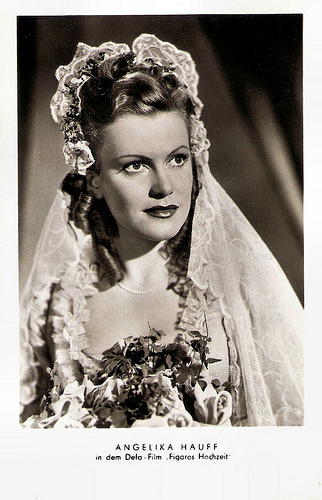
East-German postcard by VEB Volkskunstverlag Reichenbach, no. G 630. Photo: DEFA / Wunsch, Berlin. Publicity still for Figaros Hochzeit/The Marriage of Figaro (Georg Wildhagen, 1949).
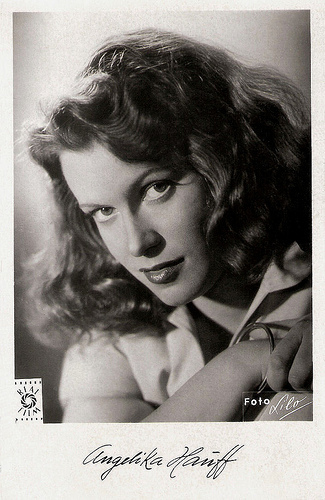
German postcard. Photo: Real Film / Lilo. Publicity still for Lockende Gefahr/Locking danger (Eugen York, 1950).
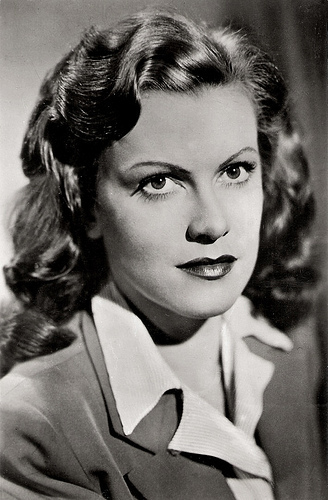
East-German postcard by VEB Progress Film-Vertrieb, Berlin, no. 458/4, 1956. Photo: Kurt Wunsch.
A deliberately escapist release
Angelika Hauff was born Alice Paula Marie Suchanek in 1922 in Vienna, Austria. From her fifth year on, she performed as a ballet dancer at the Vienna State Opera. She attended the Max Reinhardt seminar and in 1942 received an engagement at the Salzburg Landestheater.
That year she also made her film debut. Her second film was already a starring role in the German drama Zirkus Renz/Circus Renz (Arthur Maria Rabenalt, 1943) co-starring René Deltgen . The circus film was made as a deliberately escapist release at a time when the Second World War was starting to turn against Germany and its allies. The film takes its title from the real Circus Renz.
Four more films followed until the end of 1945. After the Second World War the young artist worked in both parts of Germany. She starred opposite heartthrob Rudolf Prack in the Austrian romance Konigin der Landstrasse/The Queen of the Landstrasse (Géza von Cziffra, 1948).
In East-Germany she starred in Figaros Hochzeit/The Marriage of Figaro (Georg Wildhagen, 1949) with Willi Domgraf-Fassbaender and Sabine Peters. It was based on the opera The Marriage of Figaro by Wolfgang Amadeus Mozart and Lorenzo da Ponte, which was itself based on the play The Marriage of Figaro by Pierre Beaumarchais. Hauff plays the chambermaid Susanna, around whom the men fight. The film was the first opera film made by DEFA, the state studio of East Germany, and it was a huge success with 5,479,427 tickets sold.
That same year, she played again with René Deltgen in a circus film, Tromba/Tromba: The Tiger Man (Helmut Weiss, 1949). It was one of the most popular West German films of the year, suggesting audiences supported a shift away from rubble films. In the German crime film Schwarze Augen/Dark Eyes (Géza von Bolváry, 1951), she co-starred with Cornell Borchers and Will Quadflieg .
In Italy, she appeared in the comedy Martin Toccaferro (Leonardo De Mitri, 1953) starring Peppino De Filippo . She started to play supporting parts such as in the Austrian drama Kaiserwalzer/The Emperor Waltz (Franz Antel, 1953), starring Maria Holst , and set set during the era of Empress Elisabeth of Austria. Other supporting parts followed in the final Henny Porten film, the East-German crime film Das Fräulein von Scuderi (Eugen York, 1955), and in Mozart/The Life and Loves of Mozart (Karl Hartl, 1955), which explores the mental state of Mozart (played by Oskar Werner ) during production of his final opera Die Zauberflöte.
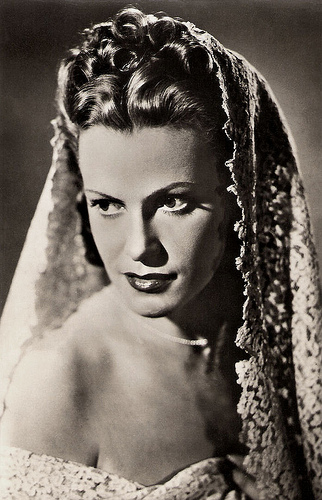
East-German postcard by VEB Progress Filmvertrieb, no. 620/64. Photo: DEFA / Neufeld. Publicity still for Figaros Hochzeit/The Marriage of Figaro (Georg Wildhagen, 1949).
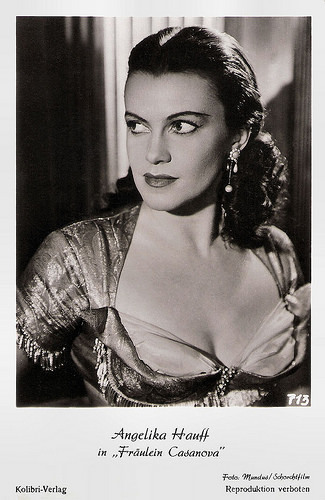
German postcard by Kolibri-Verlag. Photo: Mundus / Schorcht-Film. Publicity still for Fräulein Casanova / Miss Casanova (E.W. Emo, 1953).
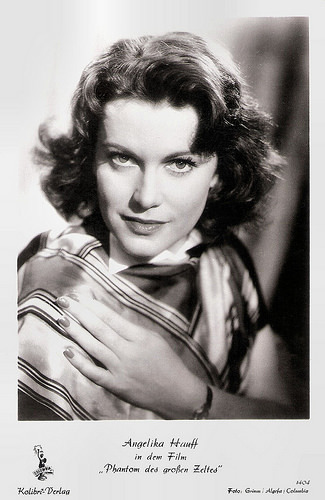
German postcard by Kolibri-Verlag, no. 1494. Photo: Arthur Grimm / Algefa / Columbia. Publicity still for Das Phantom des grossen Zeltes/The phantom of the great tent (Paul May, 1954).
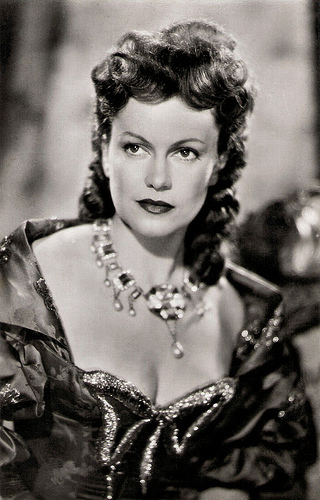
East-German postcard by VEB Progress Film-Vertrieb, Berlin, no. 532/127. Photo: DEFA / Neufeld. Publicity still for Das Fräulein von Scuderi/The Girl from Scuderi (Eugen York, 1955).
A depiction of obsession
In the following decades, Angelika Hauff’s stage work became more important. From 1955 until her death, she was a member of the Vienna Burgtheater. She also travelled through Germany, playing at the Schloßpark-Theater Berlin, and the Kammerspielen in Munich. On TV, she appeared in the popular adventure series Der Kurier der Kaiserin/The Messenger of the Empress (Hermann Leitner, 1970-1971) with Klausjürgen Wüssow.
Credited as Angelica Hauff, she returned to the screen as the mother of Olivia Pascal in the French comedy Arrête ton char... bidasse! (Michel Gérard, 1977) with Darry Cowl .
In one of her last films she played the mother of Austrian artist Egon Schiele in the international coproduction Egon Schiele – Exzess und Bestrafung/Egon Schiele – Excess and Punishment (Herbert Vesely, 1981). It stars Mathieu Carriere as Schiele with Jane Birkin as his artist muse Walburga (Wally) Neuzil, Christine Kaufmann as his wife Edith and Kristina van Eyck as her sister.
Wikipedia : “The film is essentially a depiction of obsession and its constituents of sex, alcohol and uncontrolled emotions. Set in Austria during the Great War, Schiele is depicted as the agent of social change leading to destruction of those he loves and ultimately of himself.”
Jan Onderwater at IMDb : “Herbert Vesely was one of the promises for a new German cinema already in the 50's, but after the 60's his star was already dimmed. He made a small number of films in the 70's and 80's, all non too good. This biography of Egon Schiele, one of the most important Austrian artists, is an example of the pretensions and emptiness of a Vesely-film of later date.”
Angelika Hauff died in Vienna after a short illness in 1983, aged 60. For her work at the Burgtheater, she was awarded the title of ‘Kammertressin’ a few weeks before her death.
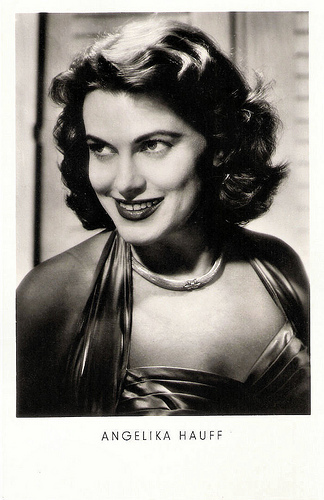
East-German postcard by VEB Volkskunstverlag Reichenbach, no. G 695.
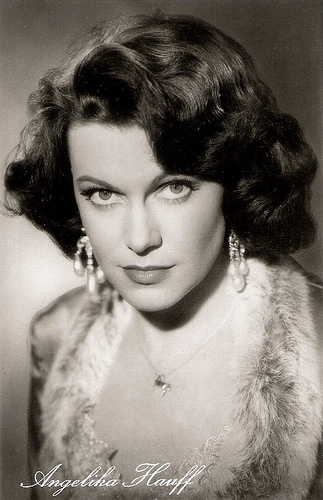
East-German postcard by VEB Progress Film-Vertrieb, Berlin, no. 299, 1958.
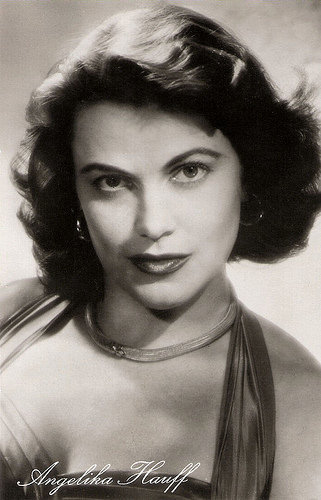
East-German postcard by VEB Progress Film-Vertrieb, Berlin, no. 235, 1958.
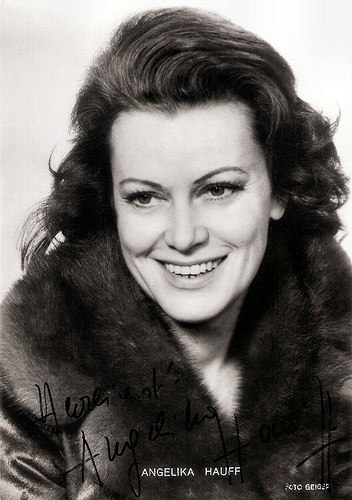
Austrian postcard. Photo: Geiger, Wien.
Sources: Jan Onderwater (IMDb), Film-Zeit.de, Wikipedia (German and English) and .

Austrian postcard by Schreiber-Karte, no. 70087. Photo: Hämmerer / Wien-Film.

East-German postcard by VEB Volkskunstverlag Reichenbach, no. G 630. Photo: DEFA / Wunsch, Berlin. Publicity still for Figaros Hochzeit/The Marriage of Figaro (Georg Wildhagen, 1949).

German postcard. Photo: Real Film / Lilo. Publicity still for Lockende Gefahr/Locking danger (Eugen York, 1950).

East-German postcard by VEB Progress Film-Vertrieb, Berlin, no. 458/4, 1956. Photo: Kurt Wunsch.
A deliberately escapist release
Angelika Hauff was born Alice Paula Marie Suchanek in 1922 in Vienna, Austria. From her fifth year on, she performed as a ballet dancer at the Vienna State Opera. She attended the Max Reinhardt seminar and in 1942 received an engagement at the Salzburg Landestheater.
That year she also made her film debut. Her second film was already a starring role in the German drama Zirkus Renz/Circus Renz (Arthur Maria Rabenalt, 1943) co-starring René Deltgen . The circus film was made as a deliberately escapist release at a time when the Second World War was starting to turn against Germany and its allies. The film takes its title from the real Circus Renz.
Four more films followed until the end of 1945. After the Second World War the young artist worked in both parts of Germany. She starred opposite heartthrob Rudolf Prack in the Austrian romance Konigin der Landstrasse/The Queen of the Landstrasse (Géza von Cziffra, 1948).
In East-Germany she starred in Figaros Hochzeit/The Marriage of Figaro (Georg Wildhagen, 1949) with Willi Domgraf-Fassbaender and Sabine Peters. It was based on the opera The Marriage of Figaro by Wolfgang Amadeus Mozart and Lorenzo da Ponte, which was itself based on the play The Marriage of Figaro by Pierre Beaumarchais. Hauff plays the chambermaid Susanna, around whom the men fight. The film was the first opera film made by DEFA, the state studio of East Germany, and it was a huge success with 5,479,427 tickets sold.
That same year, she played again with René Deltgen in a circus film, Tromba/Tromba: The Tiger Man (Helmut Weiss, 1949). It was one of the most popular West German films of the year, suggesting audiences supported a shift away from rubble films. In the German crime film Schwarze Augen/Dark Eyes (Géza von Bolváry, 1951), she co-starred with Cornell Borchers and Will Quadflieg .
In Italy, she appeared in the comedy Martin Toccaferro (Leonardo De Mitri, 1953) starring Peppino De Filippo . She started to play supporting parts such as in the Austrian drama Kaiserwalzer/The Emperor Waltz (Franz Antel, 1953), starring Maria Holst , and set set during the era of Empress Elisabeth of Austria. Other supporting parts followed in the final Henny Porten film, the East-German crime film Das Fräulein von Scuderi (Eugen York, 1955), and in Mozart/The Life and Loves of Mozart (Karl Hartl, 1955), which explores the mental state of Mozart (played by Oskar Werner ) during production of his final opera Die Zauberflöte.

East-German postcard by VEB Progress Filmvertrieb, no. 620/64. Photo: DEFA / Neufeld. Publicity still for Figaros Hochzeit/The Marriage of Figaro (Georg Wildhagen, 1949).

German postcard by Kolibri-Verlag. Photo: Mundus / Schorcht-Film. Publicity still for Fräulein Casanova / Miss Casanova (E.W. Emo, 1953).

German postcard by Kolibri-Verlag, no. 1494. Photo: Arthur Grimm / Algefa / Columbia. Publicity still for Das Phantom des grossen Zeltes/The phantom of the great tent (Paul May, 1954).

East-German postcard by VEB Progress Film-Vertrieb, Berlin, no. 532/127. Photo: DEFA / Neufeld. Publicity still for Das Fräulein von Scuderi/The Girl from Scuderi (Eugen York, 1955).
A depiction of obsession
In the following decades, Angelika Hauff’s stage work became more important. From 1955 until her death, she was a member of the Vienna Burgtheater. She also travelled through Germany, playing at the Schloßpark-Theater Berlin, and the Kammerspielen in Munich. On TV, she appeared in the popular adventure series Der Kurier der Kaiserin/The Messenger of the Empress (Hermann Leitner, 1970-1971) with Klausjürgen Wüssow.
Credited as Angelica Hauff, she returned to the screen as the mother of Olivia Pascal in the French comedy Arrête ton char... bidasse! (Michel Gérard, 1977) with Darry Cowl .
In one of her last films she played the mother of Austrian artist Egon Schiele in the international coproduction Egon Schiele – Exzess und Bestrafung/Egon Schiele – Excess and Punishment (Herbert Vesely, 1981). It stars Mathieu Carriere as Schiele with Jane Birkin as his artist muse Walburga (Wally) Neuzil, Christine Kaufmann as his wife Edith and Kristina van Eyck as her sister.
Wikipedia : “The film is essentially a depiction of obsession and its constituents of sex, alcohol and uncontrolled emotions. Set in Austria during the Great War, Schiele is depicted as the agent of social change leading to destruction of those he loves and ultimately of himself.”
Jan Onderwater at IMDb : “Herbert Vesely was one of the promises for a new German cinema already in the 50's, but after the 60's his star was already dimmed. He made a small number of films in the 70's and 80's, all non too good. This biography of Egon Schiele, one of the most important Austrian artists, is an example of the pretensions and emptiness of a Vesely-film of later date.”
Angelika Hauff died in Vienna after a short illness in 1983, aged 60. For her work at the Burgtheater, she was awarded the title of ‘Kammertressin’ a few weeks before her death.

East-German postcard by VEB Volkskunstverlag Reichenbach, no. G 695.

East-German postcard by VEB Progress Film-Vertrieb, Berlin, no. 299, 1958.

East-German postcard by VEB Progress Film-Vertrieb, Berlin, no. 235, 1958.

Austrian postcard. Photo: Geiger, Wien.
Sources: Jan Onderwater (IMDb), Film-Zeit.de, Wikipedia (German and English) and .
Published on May 08, 2017 22:00
May 7, 2017
Claude Borelli
French starlet Claude Borelli (1934-1960) appeared in French films of the 1950s. In 1960, she died after a fall, only 26 years old.
German postcard by Ufa, no. 368. Photo: Ewald / Eichberg Film / Panorama Film. Publicity still for Gestatten, mein Name ist Cox/Allow me, my name is Cox (Georg Jacoby, 1955).
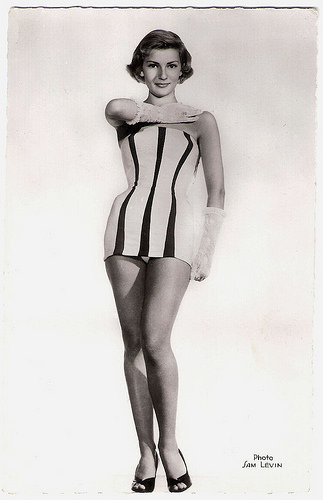
French postcard by Editions du Globe, Paris, no. 364. Photo: Sam Lévin.
The Most Beautiful Girl in the World
Claude Borelli was born Claude Alice Marthe Plattner in 1934 In Paris. Little is known about her private life, so I will focus in this bio on her short career in the cinema
She made her film debut in the small part as a bacchant in Jean Cocteau's Orphée (1950), starring Jean Marais . Next the pretty starlet played a competitor in a miss pageant in La Plus Belle Fille du monde/The Most Beautiful Girl in the World (Christian Stengel, 1951), starring Françoise Arnoul. She also had a small part in the French-Italian melodrama Quand tu liras cette lettre/When You Read This Letter (Jean-Pierre Melville, 1953) starring Juliette Gréco and Philippe Lemaire .
Borelli had a bigger role in the Lemmy Caution adventure Cet homme est dangereux/This Man is Dangerous (Jean Sacha, 1953) featuring Eddie Constantine . She also played a starlet in Les Intrigantes/The Scheming Women (Henri Decoin, 1954) with Raymond Rouleau and Jeanne Moreau .
In Germany, she finally got a leading role in the crime film Gestatten, mein Name ist Cox/Allow me, my name is Cox (Georg Jacoby, 1955) opposite Johannes Heesters . Her other films included the comedy Le Fil à la pate (Guy Lefranc, 1955), an adaptation of a Georges Feydeau's farce, and Les Truands (Carlo Rim, 1956) with Eddie Constantine .
Only 26, Claude Borelli died after a fall accident in Paris on 15 November 1960. She was married to Jean-Louis Viale.
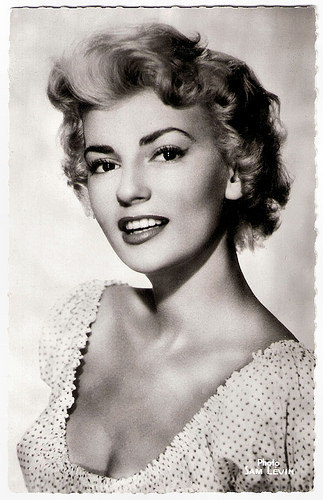
French postcard by Editions du Globe, Paris, no. 368. Photo: Sam Lévin.
Sources: Les Gens du Cinema (French), Wikipedia (French) and .
German postcard by Ufa, no. 368. Photo: Ewald / Eichberg Film / Panorama Film. Publicity still for Gestatten, mein Name ist Cox/Allow me, my name is Cox (Georg Jacoby, 1955).

French postcard by Editions du Globe, Paris, no. 364. Photo: Sam Lévin.
The Most Beautiful Girl in the World
Claude Borelli was born Claude Alice Marthe Plattner in 1934 In Paris. Little is known about her private life, so I will focus in this bio on her short career in the cinema
She made her film debut in the small part as a bacchant in Jean Cocteau's Orphée (1950), starring Jean Marais . Next the pretty starlet played a competitor in a miss pageant in La Plus Belle Fille du monde/The Most Beautiful Girl in the World (Christian Stengel, 1951), starring Françoise Arnoul. She also had a small part in the French-Italian melodrama Quand tu liras cette lettre/When You Read This Letter (Jean-Pierre Melville, 1953) starring Juliette Gréco and Philippe Lemaire .
Borelli had a bigger role in the Lemmy Caution adventure Cet homme est dangereux/This Man is Dangerous (Jean Sacha, 1953) featuring Eddie Constantine . She also played a starlet in Les Intrigantes/The Scheming Women (Henri Decoin, 1954) with Raymond Rouleau and Jeanne Moreau .
In Germany, she finally got a leading role in the crime film Gestatten, mein Name ist Cox/Allow me, my name is Cox (Georg Jacoby, 1955) opposite Johannes Heesters . Her other films included the comedy Le Fil à la pate (Guy Lefranc, 1955), an adaptation of a Georges Feydeau's farce, and Les Truands (Carlo Rim, 1956) with Eddie Constantine .
Only 26, Claude Borelli died after a fall accident in Paris on 15 November 1960. She was married to Jean-Louis Viale.

French postcard by Editions du Globe, Paris, no. 368. Photo: Sam Lévin.
Sources: Les Gens du Cinema (French), Wikipedia (French) and .
Published on May 07, 2017 22:00
May 6, 2017
Exported to the USA: Rudolph Valentino
Rudolph Valentino (1895-1926) was Hollywood's ultimate 'Latin Lover'. The Italian-born American actor starred in several well-known silent films including The Four Horsemen of the Apocalypse (1921), The Sheik (1922), Blood and Sand (1922), The Eagle (1925), and The Son of the Sheik (1926). His early death at age 31 caused mass hysteria among his fans and propelled him into iconic status.
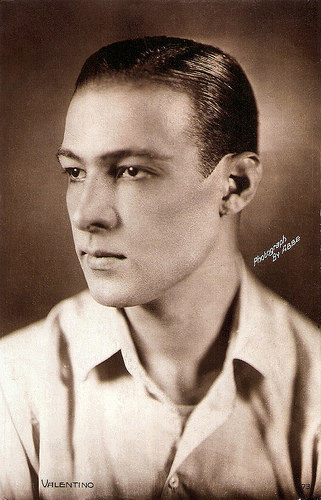
French postcard by Cinémagazine-Edition, Paris. Photo: James Abbe.
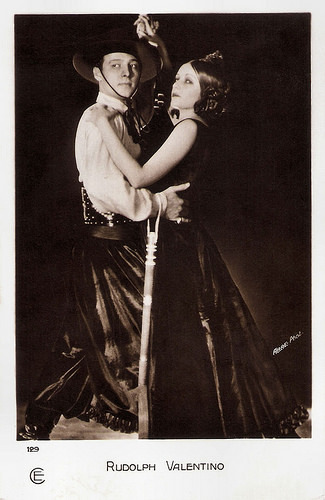
With Natacha Rambova. French postcard by Cinémagazine-Edition, no. 129. Photo: James Abbe.
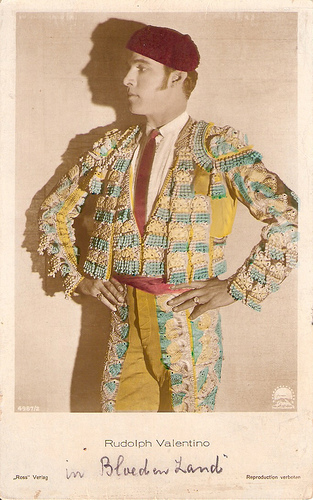
German postcard by Ross Verlag, no. 4987/2, 1929-1930. Photo: Paramount. Publicity still for Blood and Sand (Fred Niblo, 1922).
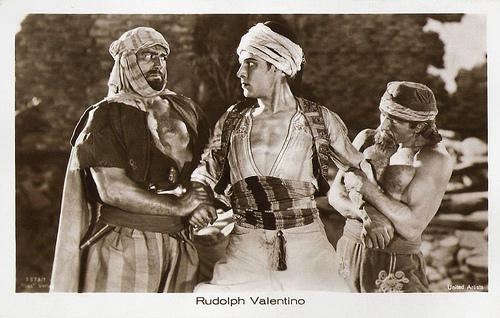
German postcard by Ross Verlag, no. 3373/1, 1928-1929. Photo: United Artists. Publicity still for The Son of the Sheik (George Fitzmaurice, 1926).
Delicious Little Devil
Rudolph Valentino was born Rodolfo Alfonso Raffaello Pierre Filibert Guglielmi di Valentina d'Antonguella in 1895 in Castellaneta, Apulia, Kingdom of Italy. He had a French mother, Marie Berta Gabrielle née Barbin, and an Italian father, Giovanni Antonio Giuseppe Fedele Guglielmi di Valentina d'Antonguella, a veterinarian who died of malaria when Rodolfo was 11.
Unable to secure employment, the 18-years-old Rodolfo departed for the United States in 1913. In New York, the handsome young man supported himself as taxi dancer (someone who danced with women for 10 cents a dance), among other occupations. In 1917, Valentino joined an operetta company that travelled to Utah, where it disbanded.
He then joined an Al Jolson production of Robinson Crusoe, Jr. which was travelling to Los Angeles. By fall, he was in San Francisco with a bit part in a theatrical production of Nobody Home.
While in town, actor Norman Kerry, helped Valentino land a few minor roles in films and by 1919 the young Italian was typecast as a shifty-eyed Latino villain.
He appeared as second lead in The Delicious Little Devil (Robert Z. Leonard, 1919) with Mae Murray. He was credited as as Rudolpho De Valintine.
During this period he married small time actress Jean Acker. Acker was a lesbian, involved in a love triangle with actresses Grace Darmond and Alla Nazimova , and the union with Valentino didn't last long.
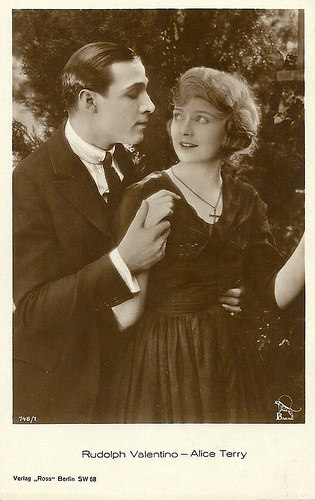
German postcard by Ross Verlag, no. 748/1. Photo: Bafag. Publicity still of Rudolph Valentino and Alice Terry in The Four Horsemen of the Apocalypse (Rex Ingram, 1921) with Alice Terry.
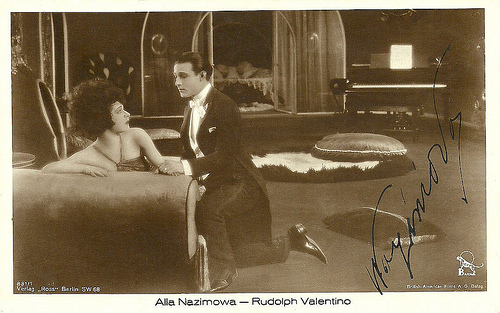
German postcard by Ross Verlag, no. 831/1, 1925-1926. Photo: British American Films / Balag. Collection: Didier Hanson. Publicity still for Camille (Ray C. Smallwood, 1921) with Alla Nazimova .
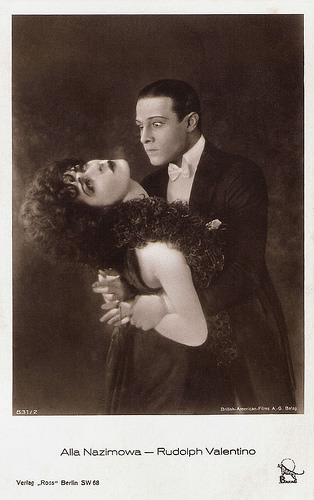
German postcard by Ross Verlag, Berlin, no. 831/2, 1925-1926. Photo: British-American-Films A.G. (Bafag). Publicity still for Camille (Ray C. Smallwood, 1921) with Alla Nazimova .
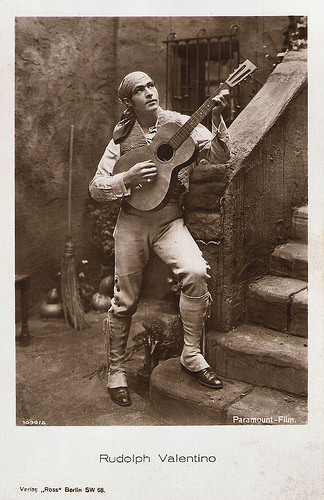
German postcard by Ross Verlag, no. 1090/5, 1927-1928. Photo: Paramount-Film. Publicity still for Blood and Sand (Fred Niblo, 1922).
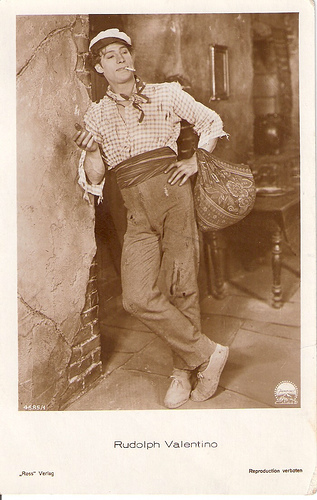
German postcard by Ross Verlag, no. 4685/1, 1929-1930. Photo: Paramount. Publicity still for Blood and Sand (Fred Niblo, 1922).
Unique brand of sexual charisma
Finally in 1921, Rudolph Valentino's star potential was realised by screenwriter June Mathis, who convinced director Rex Ingram to cast Valentino as Julio Desnoyers in The Four Horseman of the Apocalypse (1921). A sensation was the scene in which he dances a sensual tango.
The Four Horseman of the Apocalypse became a critical success, and was one of the first films to make $1,000,000 at the box office. It remains to this day the sixth-highest grossing silent film ever.
Valentino's unique brand of sexual charisma scored an immediate hit with the public, but Metro failed to capitalise on their new personality. For his follow-up film, they forced him into a bit part in a B-film called Uncharted Seas (Wesley Ruggles, 1921). On this film, Valentino met his second wife, Natacha Rambova.
Rambova, Mathis, Ivano, and Valentino began work on the Alla Nazimova film Camille (Ray C. Smallwood, 1921), based on the novel by Alexandre Dumas fils. Valentino was cast in the role of the idealistic young Armand, who falls in love with the older courtesan Camille (Nazimova). The film, mostly under the control of Rambova and Nazimova, was considered too avant garde by critics and the public.
Valentino then accepted an offer at Famous Players-Lasky, forerunner of the present-day Paramount Pictures. Here he co-starred with Agnes Ayres in The Sheik (George Melford, 1922), a role that would solidify his reputation as the ‘Latin lover’. Hal Erickson at AllMovie : “Despite the film's shortcomings, Valentino's magnetic personality permeated every frame, firmly establishing him as a star of the first rank.”
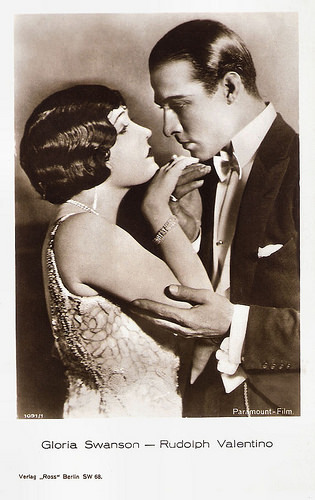
German postcard by Ross Verlag, Berlin, no. 1091/1, 1927-1928. Photo: Paramount-Film. Publicity still for Beyond the Rocks (Sam Wood, 1922) with Gloria Swanson .
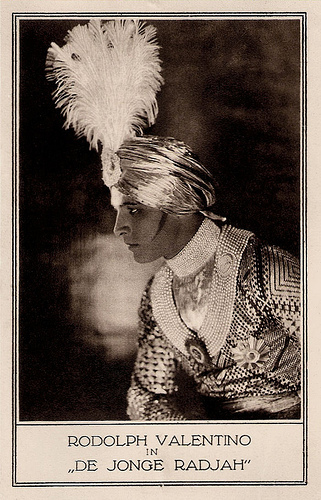
Dutch postcard, 1924. Publicity card to promote The Young Rajah (Phil Rosen, 1922), which was presented in the Asta Theatre in The Hague, The Netherlands. Rudolph Valentino was in this film credited as Rodolph Valentino. The Young Rajah was reportedly a lost film, but a few years ago the last forty minutes of a nitrate print were discovered. Paramount used stills and trailers to reconstruct the film and did according to reviewer Ischlake on IMDb a very commendable job.
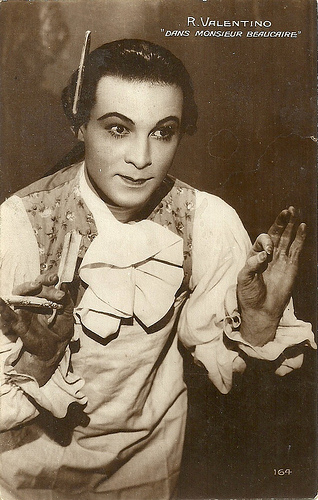
French postcard by Édition Cinémagazine, no. 164. Photo: Rudolph Valentino in Monsieur Beaucaire (Sidney Olcott, 1924).
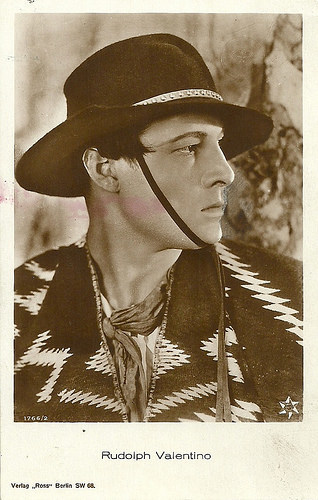
German postcard by Ross Verlag, no. 1766/2, 1927-1928. Rudolph Valentino in the American silent film A Sainted Devil (Joseph Henabery, 1924).
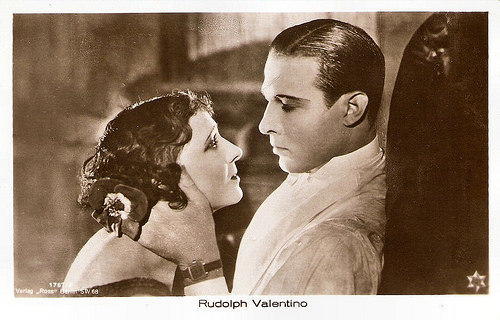
German postcard for Ross Verlag, Berlin, no. 1787/2, 1927-1928. Photo: Famous Players-Lasky Corporation. Publicity still for A Sainted Devil (Joseph Henabery, 1924) with Helen d'Algy.
Pink powder puff
Rudolph Valentino was rushed by Paramount from one film to another. He starred alongside Gloria Swanson in Beyond the Rocks (Sam Wood, 1922), but it was a critical disappointment.
Valentino began work on another Mathis-penned film, Blood and Sand (Fred Niblo, 1922), co-starring with vamp Nita Naldi. Valentino played the bullfighter Juan Gallardo. He initially believed the film would be shot in Spain, and was upset to learn that the studio planned on shooting on a Hollywood back lot.
After finishing the film, Valentino married Rambova, which led to a sensational bigamy trial. The pair was forced to have their marriage annulled and separated for a year. Despite the trial, the film was still a success. Blood and Sand went on to become one of the top-four grossing movies of 1922, and Valentino considered this one of his best films.
Valentino took a two-year sabbatical, devoting his time to writing and publishing poetry. He returned to the screen in such disappointing productions as Monsieur Beaucaire (Sidney Olcott, 1924) and Cobra (Joseph Henabery, 1925). A columnist for the Chicago Tribune, characterised the actor as a 'pink powder puff'. Valentino angrily challenged the writer to a fistfight, but the waspish scrivener refused.
Valentino divorced his second wife Natasha Rambova and formed his own production company, playing virile leading roles in The Eagle (Clarence Brown, 1925) and Son of the Sheik (George Fitzmaurice, 1926), two of his best films.
A few months after completing Son of the Sheik, he was hospitalised in New York with a perforated ulcer. Complications quickly set in, and on 23 August 1926, the 31-year-old actor died. Nearly 80,000 hysterical women, including actress Pola Negri, crowded into Campbell's Funeral Parlour in New York.
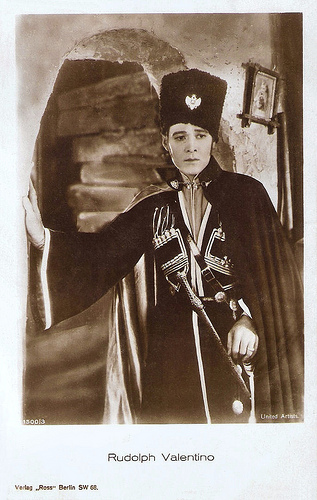
German postcard by Ross Verlag, no. 1500/3, 1927-1928. Photo: United Artists. Publicity still of Rudolph Valentino in The Eagle (Clarence Brown, 1925
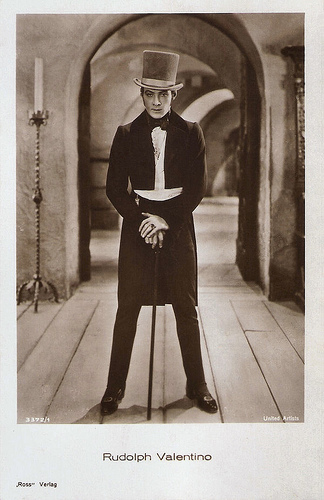
German postcard by Ross Verlag, Berlin, no. 3372/1, 1928-1929. Photo: United Artists. Publicity still of Rudolph Valentino in The Eagle (Clarence Brown, 1925).
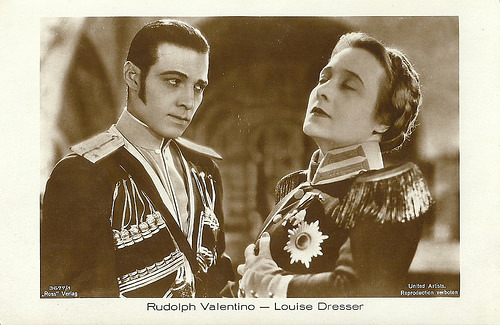
German postcard by Ross Verlag, no. 3677/1, 1928-1929. Photo: United Artists. Publicity still of Rudolph Valentino and Louise Dresser in The Eagle (Clarence Brown, 1925).
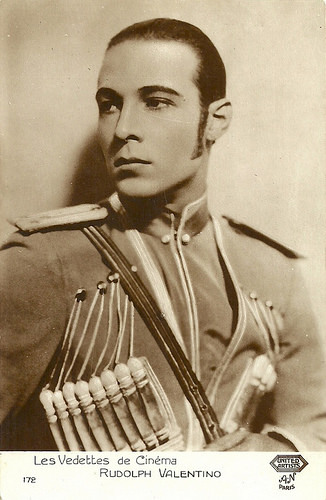
French postcard by A.N., Paris, no. 172. Photo: United Artists. Publicity still of Rudolph Valentino in The Eagle (Clarence Brown, 1925)
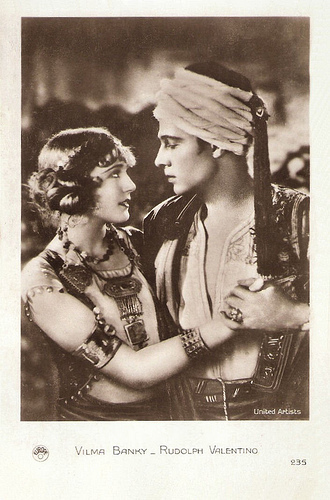
French postcard by Europa, no. 235. Photo: United Artists. Publicity still for The Son of the Sheik (George Fitzmaurice, 1926) with Vilma Banky.
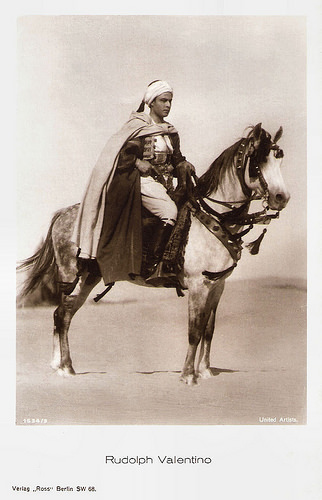
German postcard by Ross Verlag, no. 1534/3, 1927-1928. Photo: United Artists. Publicity still for The Son of the Sheik (George Fitzmaurice, 1926).
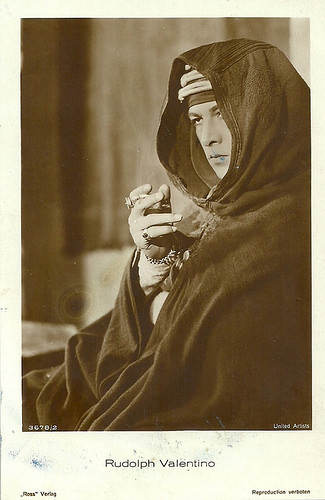
German postcard by Ross Verlag, no. 3678/2, 1928-1929. Photo: United Artists. Publicity still of Rudolph Valentino in The Son of the Sheik (George Fitzmaurice, 1926).
Sources: Hal Erickson (AllMovie), Wikipedia, and .

French postcard by Cinémagazine-Edition, Paris. Photo: James Abbe.

With Natacha Rambova. French postcard by Cinémagazine-Edition, no. 129. Photo: James Abbe.

German postcard by Ross Verlag, no. 4987/2, 1929-1930. Photo: Paramount. Publicity still for Blood and Sand (Fred Niblo, 1922).

German postcard by Ross Verlag, no. 3373/1, 1928-1929. Photo: United Artists. Publicity still for The Son of the Sheik (George Fitzmaurice, 1926).
Delicious Little Devil
Rudolph Valentino was born Rodolfo Alfonso Raffaello Pierre Filibert Guglielmi di Valentina d'Antonguella in 1895 in Castellaneta, Apulia, Kingdom of Italy. He had a French mother, Marie Berta Gabrielle née Barbin, and an Italian father, Giovanni Antonio Giuseppe Fedele Guglielmi di Valentina d'Antonguella, a veterinarian who died of malaria when Rodolfo was 11.
Unable to secure employment, the 18-years-old Rodolfo departed for the United States in 1913. In New York, the handsome young man supported himself as taxi dancer (someone who danced with women for 10 cents a dance), among other occupations. In 1917, Valentino joined an operetta company that travelled to Utah, where it disbanded.
He then joined an Al Jolson production of Robinson Crusoe, Jr. which was travelling to Los Angeles. By fall, he was in San Francisco with a bit part in a theatrical production of Nobody Home.
While in town, actor Norman Kerry, helped Valentino land a few minor roles in films and by 1919 the young Italian was typecast as a shifty-eyed Latino villain.
He appeared as second lead in The Delicious Little Devil (Robert Z. Leonard, 1919) with Mae Murray. He was credited as as Rudolpho De Valintine.
During this period he married small time actress Jean Acker. Acker was a lesbian, involved in a love triangle with actresses Grace Darmond and Alla Nazimova , and the union with Valentino didn't last long.

German postcard by Ross Verlag, no. 748/1. Photo: Bafag. Publicity still of Rudolph Valentino and Alice Terry in The Four Horsemen of the Apocalypse (Rex Ingram, 1921) with Alice Terry.

German postcard by Ross Verlag, no. 831/1, 1925-1926. Photo: British American Films / Balag. Collection: Didier Hanson. Publicity still for Camille (Ray C. Smallwood, 1921) with Alla Nazimova .

German postcard by Ross Verlag, Berlin, no. 831/2, 1925-1926. Photo: British-American-Films A.G. (Bafag). Publicity still for Camille (Ray C. Smallwood, 1921) with Alla Nazimova .

German postcard by Ross Verlag, no. 1090/5, 1927-1928. Photo: Paramount-Film. Publicity still for Blood and Sand (Fred Niblo, 1922).

German postcard by Ross Verlag, no. 4685/1, 1929-1930. Photo: Paramount. Publicity still for Blood and Sand (Fred Niblo, 1922).
Unique brand of sexual charisma
Finally in 1921, Rudolph Valentino's star potential was realised by screenwriter June Mathis, who convinced director Rex Ingram to cast Valentino as Julio Desnoyers in The Four Horseman of the Apocalypse (1921). A sensation was the scene in which he dances a sensual tango.
The Four Horseman of the Apocalypse became a critical success, and was one of the first films to make $1,000,000 at the box office. It remains to this day the sixth-highest grossing silent film ever.
Valentino's unique brand of sexual charisma scored an immediate hit with the public, but Metro failed to capitalise on their new personality. For his follow-up film, they forced him into a bit part in a B-film called Uncharted Seas (Wesley Ruggles, 1921). On this film, Valentino met his second wife, Natacha Rambova.
Rambova, Mathis, Ivano, and Valentino began work on the Alla Nazimova film Camille (Ray C. Smallwood, 1921), based on the novel by Alexandre Dumas fils. Valentino was cast in the role of the idealistic young Armand, who falls in love with the older courtesan Camille (Nazimova). The film, mostly under the control of Rambova and Nazimova, was considered too avant garde by critics and the public.
Valentino then accepted an offer at Famous Players-Lasky, forerunner of the present-day Paramount Pictures. Here he co-starred with Agnes Ayres in The Sheik (George Melford, 1922), a role that would solidify his reputation as the ‘Latin lover’. Hal Erickson at AllMovie : “Despite the film's shortcomings, Valentino's magnetic personality permeated every frame, firmly establishing him as a star of the first rank.”

German postcard by Ross Verlag, Berlin, no. 1091/1, 1927-1928. Photo: Paramount-Film. Publicity still for Beyond the Rocks (Sam Wood, 1922) with Gloria Swanson .

Dutch postcard, 1924. Publicity card to promote The Young Rajah (Phil Rosen, 1922), which was presented in the Asta Theatre in The Hague, The Netherlands. Rudolph Valentino was in this film credited as Rodolph Valentino. The Young Rajah was reportedly a lost film, but a few years ago the last forty minutes of a nitrate print were discovered. Paramount used stills and trailers to reconstruct the film and did according to reviewer Ischlake on IMDb a very commendable job.

French postcard by Édition Cinémagazine, no. 164. Photo: Rudolph Valentino in Monsieur Beaucaire (Sidney Olcott, 1924).

German postcard by Ross Verlag, no. 1766/2, 1927-1928. Rudolph Valentino in the American silent film A Sainted Devil (Joseph Henabery, 1924).

German postcard for Ross Verlag, Berlin, no. 1787/2, 1927-1928. Photo: Famous Players-Lasky Corporation. Publicity still for A Sainted Devil (Joseph Henabery, 1924) with Helen d'Algy.
Pink powder puff
Rudolph Valentino was rushed by Paramount from one film to another. He starred alongside Gloria Swanson in Beyond the Rocks (Sam Wood, 1922), but it was a critical disappointment.
Valentino began work on another Mathis-penned film, Blood and Sand (Fred Niblo, 1922), co-starring with vamp Nita Naldi. Valentino played the bullfighter Juan Gallardo. He initially believed the film would be shot in Spain, and was upset to learn that the studio planned on shooting on a Hollywood back lot.
After finishing the film, Valentino married Rambova, which led to a sensational bigamy trial. The pair was forced to have their marriage annulled and separated for a year. Despite the trial, the film was still a success. Blood and Sand went on to become one of the top-four grossing movies of 1922, and Valentino considered this one of his best films.
Valentino took a two-year sabbatical, devoting his time to writing and publishing poetry. He returned to the screen in such disappointing productions as Monsieur Beaucaire (Sidney Olcott, 1924) and Cobra (Joseph Henabery, 1925). A columnist for the Chicago Tribune, characterised the actor as a 'pink powder puff'. Valentino angrily challenged the writer to a fistfight, but the waspish scrivener refused.
Valentino divorced his second wife Natasha Rambova and formed his own production company, playing virile leading roles in The Eagle (Clarence Brown, 1925) and Son of the Sheik (George Fitzmaurice, 1926), two of his best films.
A few months after completing Son of the Sheik, he was hospitalised in New York with a perforated ulcer. Complications quickly set in, and on 23 August 1926, the 31-year-old actor died. Nearly 80,000 hysterical women, including actress Pola Negri, crowded into Campbell's Funeral Parlour in New York.

German postcard by Ross Verlag, no. 1500/3, 1927-1928. Photo: United Artists. Publicity still of Rudolph Valentino in The Eagle (Clarence Brown, 1925

German postcard by Ross Verlag, Berlin, no. 3372/1, 1928-1929. Photo: United Artists. Publicity still of Rudolph Valentino in The Eagle (Clarence Brown, 1925).

German postcard by Ross Verlag, no. 3677/1, 1928-1929. Photo: United Artists. Publicity still of Rudolph Valentino and Louise Dresser in The Eagle (Clarence Brown, 1925).

French postcard by A.N., Paris, no. 172. Photo: United Artists. Publicity still of Rudolph Valentino in The Eagle (Clarence Brown, 1925)

French postcard by Europa, no. 235. Photo: United Artists. Publicity still for The Son of the Sheik (George Fitzmaurice, 1926) with Vilma Banky.

German postcard by Ross Verlag, no. 1534/3, 1927-1928. Photo: United Artists. Publicity still for The Son of the Sheik (George Fitzmaurice, 1926).

German postcard by Ross Verlag, no. 3678/2, 1928-1929. Photo: United Artists. Publicity still of Rudolph Valentino in The Son of the Sheik (George Fitzmaurice, 1926).
Sources: Hal Erickson (AllMovie), Wikipedia, and .
Published on May 06, 2017 22:00
May 5, 2017
Liane Haid
Prima ballerina, dancer, singer and actress Liane Haid (1895-2000) was the first film star of Austria. She was the epitome of the Süßes Wiener Mädel (Sweet Viennese Girl), and from the mid 1910s on she made close to a hundred films.
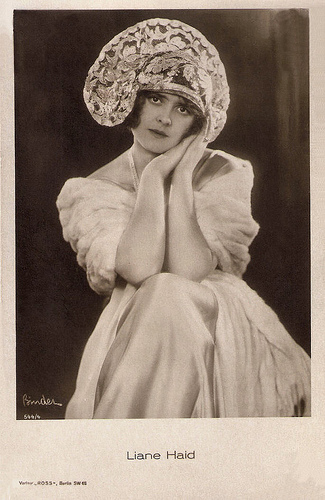
German postcard by Ross Verlag, no. 544/4, 1919-1924. Photo: Alex Binder.
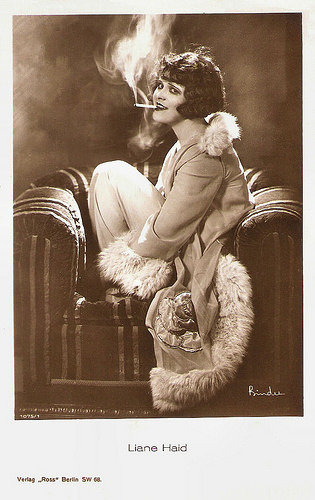
German postcard by Ross Verlag, no. 1075/2, 1927-1928. Photo: Alex Binder.
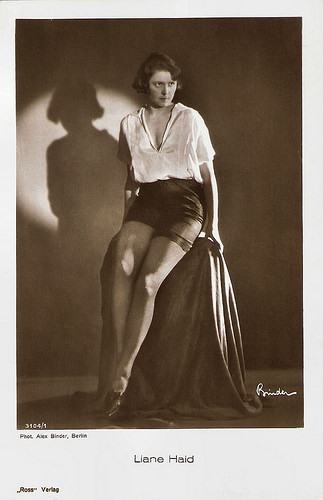
German postcard by Ross Verlag, no. 3104/1, 1928-1929. Photo: Alex Binder, Berlin.
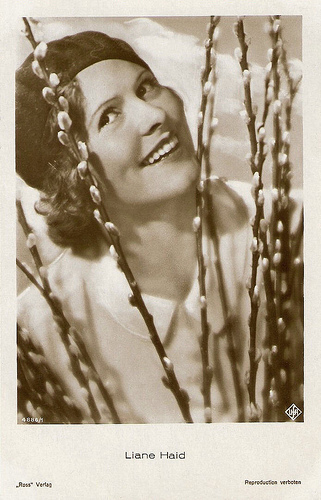
German postcard by Ross Verlag, no. 4886/1, 1929-1930. Photo: Ufa.
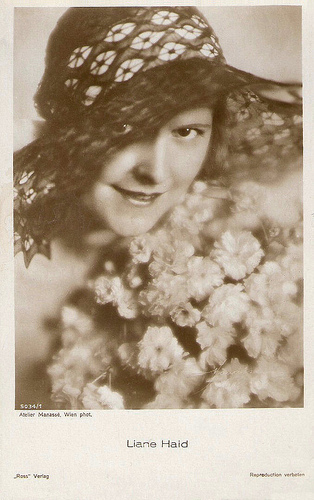
German postcard by Ross Verlag, no. 5034/1, 1930-1931. Photo: Manassé, Wien (Vienna).
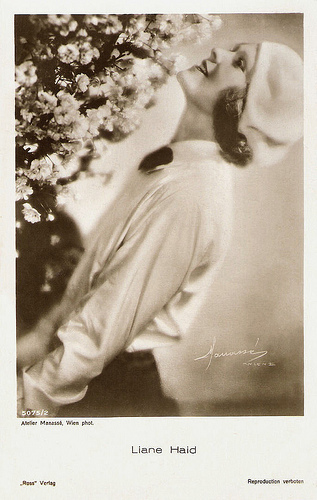
German postcard by Ross Verlag, no. 5075/2, 1930-1931. Photo: Manassé, Wien.
Propaganda Film
Juliane Haid was born in Vienna, Austria in 1895. As a child, Liane studied singing and dancing, and she danced at the Viennese Opern Ballet.
Later she worked in Budapest and Vienna as a dancer and in Berlin and Vienna as a stage actress. She had already become a popular opera and operetta singer and dancer before she made her first film appearance.
Her debut was a propaganda film made during the First World War, Mit Herz und Hand fürs Vaterland/With Heart and Hand for the Fatherland (Jacob Fleck, Luise Fleck, 1915).
Most of her early silent films were directed by the husband and wife team Jacob and Luise Fleck for Wiener Kunstfilm. These films include the silent historical film Der Verschwender/The Spendthrift (Jacob Fleck, Luise Fleck, 1917). It is an adaptation of Ferdinand Raimund's play of the same name. Her leading men in these silent films were often Wilhelm Klitsch or Max Neufeld.
After the war Haid's first husband, Baron Fritz von Haymerle, built her her own film studio in Vienna and gave her her own company.
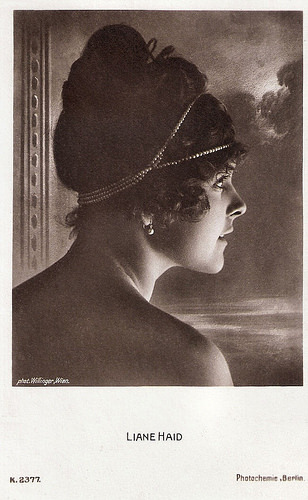
German postcard by Photochemie, Berlin, no. K. 2377. Photo: Willinger, Wien.
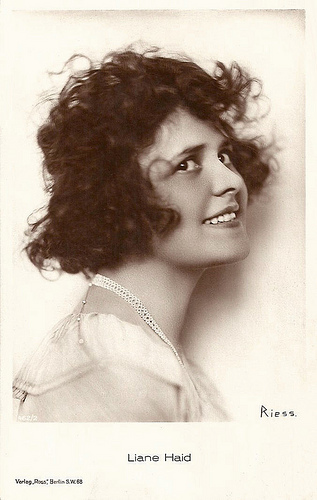
German postcard by Ross Verlag, Berlin, no. 462/2, 1919-1924. Photo: Riess.
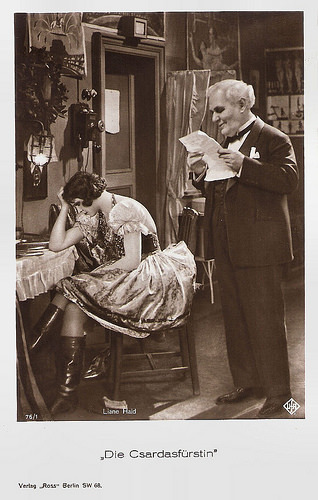
German postcard by Ross Verlag, no. 76/1. Photo: Ufa. Publicity still for Die Csardasfürstin/The Csardas Princess (Hanns Schwarz, 1927).
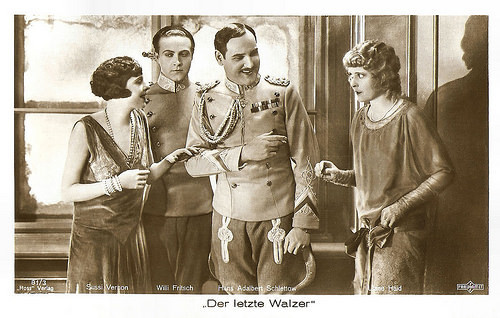
German postcard by Ross Verlag, no. 81/3/3, 1925-1935. Photo: Parufamet. Publicity still for Der Letzte Walzer/The Last Waltz (Arthur Robison, 1927) with Suzy Vernon, Willy Fritsch, Hans Adalbert Schlettow and Liane Haid.
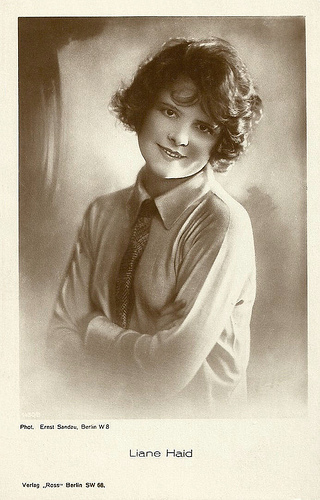
German postcard by Ross Verlag, Berlin, no. 1430/2, 1927-1928. Photo: Ernst Sandau, Berlin.
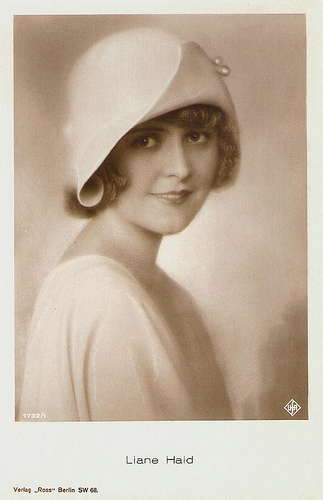
German postcard by Ross Verlag, Berlin, no. 1732/1, 1927-1928. Photo: Ufa.
Popular Pin-up
In the early 1920s Liane Haid moved to Berlin and had her breakthrough opposite Conrad Veidt in the historical film Lady Hamilton (Richard Oswald, 1921). The film depicts the love affair between the British Admiral Lord Nelson and Lady Emma Hamilton.
Next she played opposite Reinhold Schünzel in Geld auf der Straße/Money on the Street (Reinhold Schünzel, 1922). She also became a popular pin-up.
Haid appeared again opposite Conrad Veidt in the historical film Lucrezia Borgia/Bride of Vengeance (Richard Oswald, 1922) and the drama Die Brüder Schellenberg/The Brothers Schellenberg (Karl Grune, 1926) with Lil Dagover . The first portrayed the life of the Renaissance Italian aristocrat Lucrezia Borgia (1480-1519).
Also popular were the operettas Im weißen Rößl/The White Horse Inn (Richard Oswald, 1926) with Max Hansen and based on the play The White Horse Inn by Oskar Blumenthal and Gustav Kadelburg, and Die Csardasfürstin/The Csardas Princess (Hanns Schwarz, 1927) opposite Hungarian star Imre Ráday . The later was an adaptation of the operetta by Emmerich Kálmán.
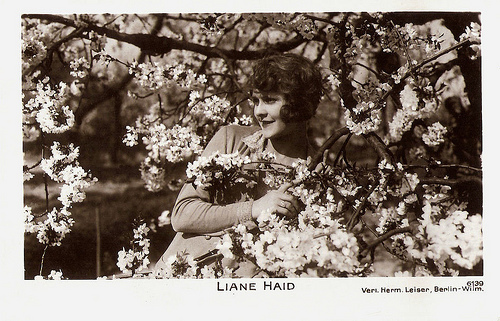
German postcard by Verlag Hermann Leiser, Berlin-Wilm., no. 6139.
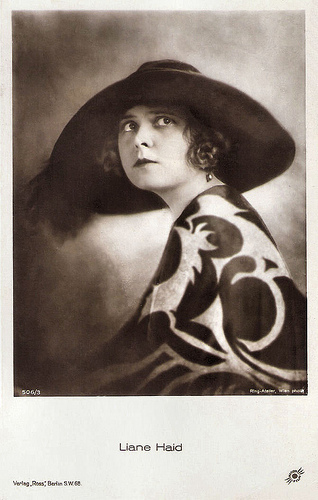
German postcard by Ross Verlag, no. 506/3, 1919-1924. Photo: Ring-Atelier, Wien.
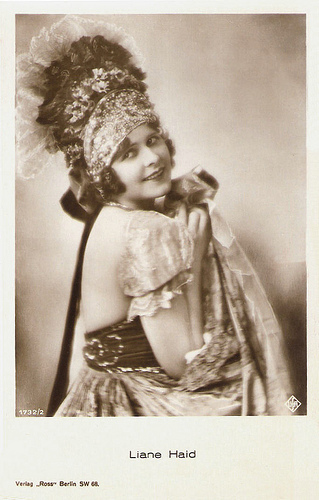
German postcard by Ross Verlag, no. 1732/2, 1927-1928. Photo: Ufa.
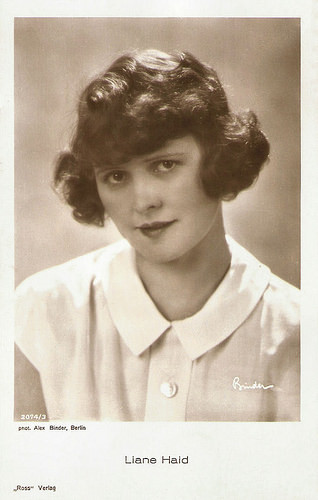
German postcard by Ross Verlag, no. 2074/3, 1927-1928. Photo: Alex Binder.
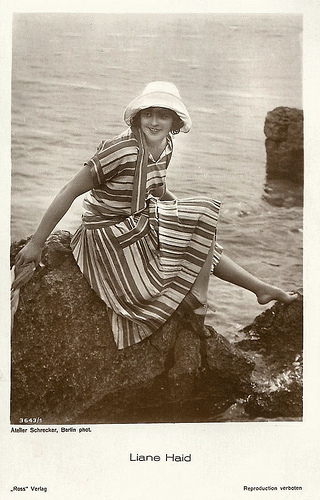
German postcard by Ross Verlag, no. 3643/1, 1928-1929. Photo: Atelier Schrecker, Berlin.
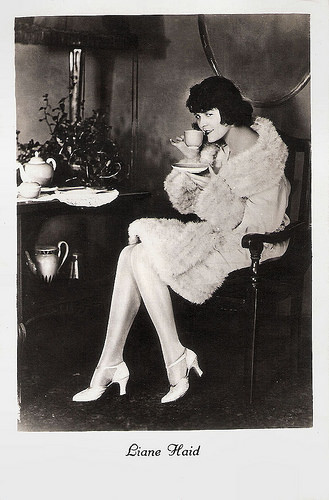
German postcard by H.C. Stöcker, Hannover-Linden, for Bemberg. Caption: "Bemberg-Seide zu tragen ist ein Vergnügen, Liane Haid". (Bemberg silk is a pleasure to wear, Liane Haid).
Smooth Switch
Liane Haid's switch to sound film went smoothly, because of her training as a singer. Her song Adieu, mein kleiner Gardenoffizier, sung in Géza von Bolváry's popular operetta Das Lied ist aus/The Song Is Over (Géza von Bolváry, 1930), was a huge success at the time.
In the biography Grock (Carl Boese, 1931) she played the wife of the famous clown (played by himself).
For Paramount she appeared in alternate language versions of their productions such as Die Männer um Lucie/The Men Around Lucy (Alexander Korda, 1931), a German version of Laughter (Harry d'Abbadie d'Arrast, 1930) with Nancy Carroll.
Haid became one of the main stars of the German cinema and she appeared opposite leading men like Willi Forst , Georg Alexander , and Gustav Fröhlich . In Ungeküsst soll man nicht schlafen gehn/You should not go to sleep unkissed (E.W. Emo, 1936), she starred opposite Heinz Rühmann , Theo Lingen and Hans Moser .
In these films she was often typecasted as the Süßes Wiener Mädel (sweet Viennese girl).
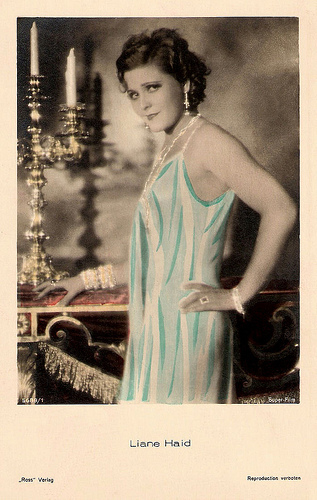
German postcard by Ross Verlag, no. 5689/1, 1930-1931. Photo: Super-Film.
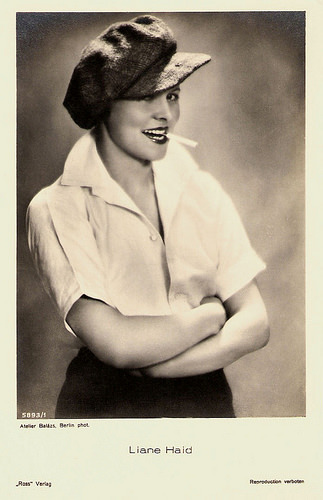
German postcard by Ross Verlag, no. 5893/1, 1930-1931. Photo: Atelier Balázs, Berlin.
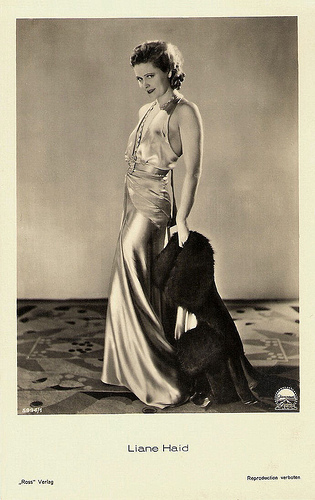
German postcard by Ross Verlag, no. 5994/1, 1930-1931. Photo: Paramount Pictures.
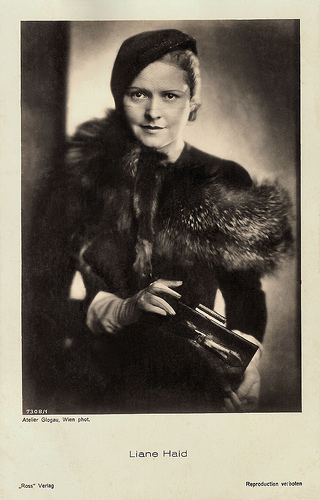
German postcard by Ross Verlag, no. 7308/1, 1932-1933. Photo: Atelier Glogau, Wien.
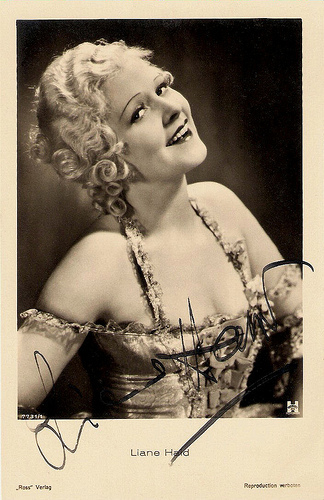
German postcard by Ross Verlag, no. 7731/1, 1932-1933. Photo: H.
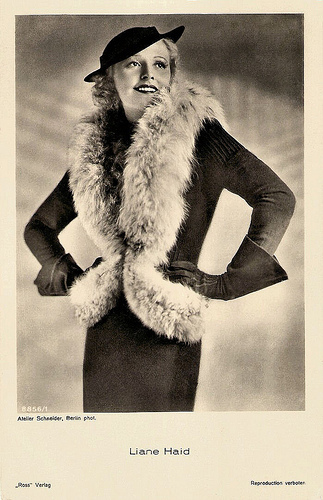
German postcard by Ross Verlag, no. 8856/1, 1933-1934. Photo: Atelier Schneider, Berlin.
Switzerland
From the mid-1930s Liane Haid's roles were less frequent. She played a part in the British production Whom the Gods Love: The Original Story of Mozart and His Wife (Basil Dean, 1936). The film was a disaster.
She refused offers from Hollywood and instead focused on her stage career. In 1942 she emigrated with her son to Switzerland. According to Wikipedia she later said about it: "because of the regime, because everything was bombed, and because all the good directors had left".
In Switzerland she married Dr. Carl Spycher. It was her third marriage. Their son is the jazz musician Pierre Spycher.
Haid made her last film appearance in the Austrian romantic comedy Die Fünf Karnickel/The five rabbits (Kurt Steinwendner, Paul Löwinger, 1953), starring Ingrid Lutz.
Liane Haid died in 2000 in Wabern near Bern, at the age of 105. Her sister Grit Haid was less fortunate. Grit was an equally well-known film actress, who was active in the late 1920s and early 1930s. She suddenly died tragically in a plane accident in 1938.
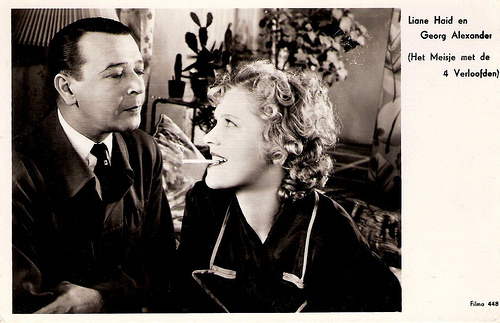
Dutch postcard by Filma, no. 448. Photo: publicity still for Eine Frau wie Du/A Woman Like You (Carl Boese, 1933) with Georg Alexander .
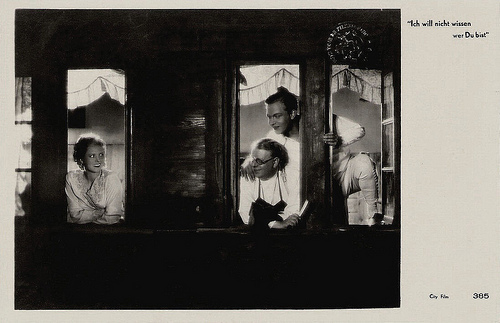
Dutch postcard by JosPe, Arnhem for City Film, no. 385. Photo: publicity still for Ich will nicht wissen, wer du bist/I don't Wanna Know Who You Are (Géza von Bolváry, 1932) with Gustav Fröhlich and Szöke Szakáll .
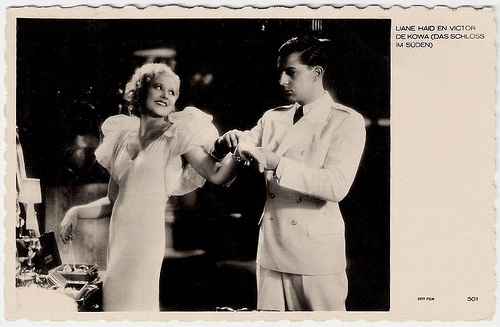
Dutch postcard by City Film, no. 501. Photo: publicity still for Das Schloß im Süden/The Castle in the South (Géza von Bolváry, 1933) with Viktor de Kowa .
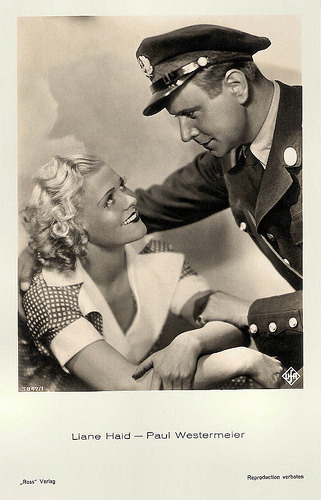
German postcard by Ross Verlag, no. 7847/1, 1932-1933. Photo: Ufa. Publicity still for Der Stern von Valencia/The Star of Valencia (Alfred Zeisler, 1933) with Paul Westermeier.
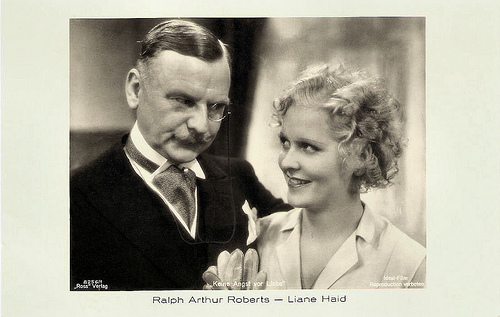
German postcard by Ross Verlag, no. 8256/1, 1933-1934. Photo: Ideal-Film, Berlin. Publicity still of Ralph A. Roberts and Liane Haid in for Keine Angst vor Liebe/Don't Be Afraid of Love (Hans Steinhoff, 1933).
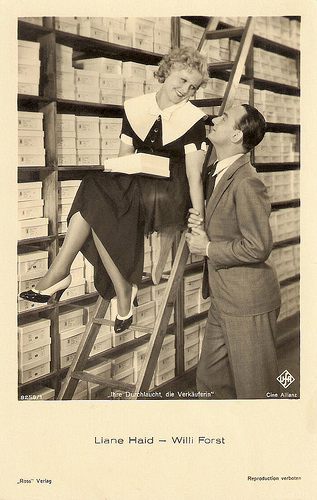
German postcard by Ross Verlag, no. 8258/1, 1933-1934. Photo: Ufa / Cine Allianz. Publicity still for Ihre Durchlaucht, die Verkäuferin/Her Excellency, the Salesgirl (Karl Hartl, 1933) with Willi Forst .
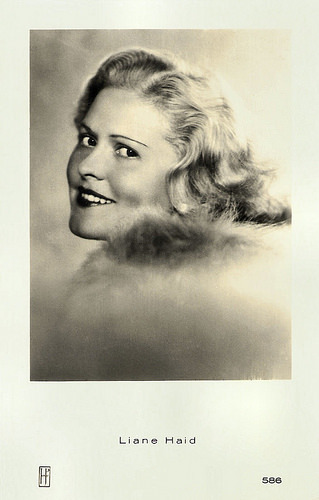
Dutch postcard by JosPe, no. 586.
Sources: Thomas Staedeli (Cyranos), (IMDb), Wikipedia, and .

German postcard by Ross Verlag, no. 544/4, 1919-1924. Photo: Alex Binder.

German postcard by Ross Verlag, no. 1075/2, 1927-1928. Photo: Alex Binder.

German postcard by Ross Verlag, no. 3104/1, 1928-1929. Photo: Alex Binder, Berlin.

German postcard by Ross Verlag, no. 4886/1, 1929-1930. Photo: Ufa.

German postcard by Ross Verlag, no. 5034/1, 1930-1931. Photo: Manassé, Wien (Vienna).

German postcard by Ross Verlag, no. 5075/2, 1930-1931. Photo: Manassé, Wien.
Propaganda Film
Juliane Haid was born in Vienna, Austria in 1895. As a child, Liane studied singing and dancing, and she danced at the Viennese Opern Ballet.
Later she worked in Budapest and Vienna as a dancer and in Berlin and Vienna as a stage actress. She had already become a popular opera and operetta singer and dancer before she made her first film appearance.
Her debut was a propaganda film made during the First World War, Mit Herz und Hand fürs Vaterland/With Heart and Hand for the Fatherland (Jacob Fleck, Luise Fleck, 1915).
Most of her early silent films were directed by the husband and wife team Jacob and Luise Fleck for Wiener Kunstfilm. These films include the silent historical film Der Verschwender/The Spendthrift (Jacob Fleck, Luise Fleck, 1917). It is an adaptation of Ferdinand Raimund's play of the same name. Her leading men in these silent films were often Wilhelm Klitsch or Max Neufeld.
After the war Haid's first husband, Baron Fritz von Haymerle, built her her own film studio in Vienna and gave her her own company.

German postcard by Photochemie, Berlin, no. K. 2377. Photo: Willinger, Wien.

German postcard by Ross Verlag, Berlin, no. 462/2, 1919-1924. Photo: Riess.

German postcard by Ross Verlag, no. 76/1. Photo: Ufa. Publicity still for Die Csardasfürstin/The Csardas Princess (Hanns Schwarz, 1927).

German postcard by Ross Verlag, no. 81/3/3, 1925-1935. Photo: Parufamet. Publicity still for Der Letzte Walzer/The Last Waltz (Arthur Robison, 1927) with Suzy Vernon, Willy Fritsch, Hans Adalbert Schlettow and Liane Haid.

German postcard by Ross Verlag, Berlin, no. 1430/2, 1927-1928. Photo: Ernst Sandau, Berlin.

German postcard by Ross Verlag, Berlin, no. 1732/1, 1927-1928. Photo: Ufa.
Popular Pin-up
In the early 1920s Liane Haid moved to Berlin and had her breakthrough opposite Conrad Veidt in the historical film Lady Hamilton (Richard Oswald, 1921). The film depicts the love affair between the British Admiral Lord Nelson and Lady Emma Hamilton.
Next she played opposite Reinhold Schünzel in Geld auf der Straße/Money on the Street (Reinhold Schünzel, 1922). She also became a popular pin-up.
Haid appeared again opposite Conrad Veidt in the historical film Lucrezia Borgia/Bride of Vengeance (Richard Oswald, 1922) and the drama Die Brüder Schellenberg/The Brothers Schellenberg (Karl Grune, 1926) with Lil Dagover . The first portrayed the life of the Renaissance Italian aristocrat Lucrezia Borgia (1480-1519).
Also popular were the operettas Im weißen Rößl/The White Horse Inn (Richard Oswald, 1926) with Max Hansen and based on the play The White Horse Inn by Oskar Blumenthal and Gustav Kadelburg, and Die Csardasfürstin/The Csardas Princess (Hanns Schwarz, 1927) opposite Hungarian star Imre Ráday . The later was an adaptation of the operetta by Emmerich Kálmán.

German postcard by Verlag Hermann Leiser, Berlin-Wilm., no. 6139.

German postcard by Ross Verlag, no. 506/3, 1919-1924. Photo: Ring-Atelier, Wien.

German postcard by Ross Verlag, no. 1732/2, 1927-1928. Photo: Ufa.

German postcard by Ross Verlag, no. 2074/3, 1927-1928. Photo: Alex Binder.

German postcard by Ross Verlag, no. 3643/1, 1928-1929. Photo: Atelier Schrecker, Berlin.

German postcard by H.C. Stöcker, Hannover-Linden, for Bemberg. Caption: "Bemberg-Seide zu tragen ist ein Vergnügen, Liane Haid". (Bemberg silk is a pleasure to wear, Liane Haid).
Smooth Switch
Liane Haid's switch to sound film went smoothly, because of her training as a singer. Her song Adieu, mein kleiner Gardenoffizier, sung in Géza von Bolváry's popular operetta Das Lied ist aus/The Song Is Over (Géza von Bolváry, 1930), was a huge success at the time.
In the biography Grock (Carl Boese, 1931) she played the wife of the famous clown (played by himself).
For Paramount she appeared in alternate language versions of their productions such as Die Männer um Lucie/The Men Around Lucy (Alexander Korda, 1931), a German version of Laughter (Harry d'Abbadie d'Arrast, 1930) with Nancy Carroll.
Haid became one of the main stars of the German cinema and she appeared opposite leading men like Willi Forst , Georg Alexander , and Gustav Fröhlich . In Ungeküsst soll man nicht schlafen gehn/You should not go to sleep unkissed (E.W. Emo, 1936), she starred opposite Heinz Rühmann , Theo Lingen and Hans Moser .
In these films she was often typecasted as the Süßes Wiener Mädel (sweet Viennese girl).

German postcard by Ross Verlag, no. 5689/1, 1930-1931. Photo: Super-Film.

German postcard by Ross Verlag, no. 5893/1, 1930-1931. Photo: Atelier Balázs, Berlin.

German postcard by Ross Verlag, no. 5994/1, 1930-1931. Photo: Paramount Pictures.

German postcard by Ross Verlag, no. 7308/1, 1932-1933. Photo: Atelier Glogau, Wien.

German postcard by Ross Verlag, no. 7731/1, 1932-1933. Photo: H.

German postcard by Ross Verlag, no. 8856/1, 1933-1934. Photo: Atelier Schneider, Berlin.
Switzerland
From the mid-1930s Liane Haid's roles were less frequent. She played a part in the British production Whom the Gods Love: The Original Story of Mozart and His Wife (Basil Dean, 1936). The film was a disaster.
She refused offers from Hollywood and instead focused on her stage career. In 1942 she emigrated with her son to Switzerland. According to Wikipedia she later said about it: "because of the regime, because everything was bombed, and because all the good directors had left".
In Switzerland she married Dr. Carl Spycher. It was her third marriage. Their son is the jazz musician Pierre Spycher.
Haid made her last film appearance in the Austrian romantic comedy Die Fünf Karnickel/The five rabbits (Kurt Steinwendner, Paul Löwinger, 1953), starring Ingrid Lutz.
Liane Haid died in 2000 in Wabern near Bern, at the age of 105. Her sister Grit Haid was less fortunate. Grit was an equally well-known film actress, who was active in the late 1920s and early 1930s. She suddenly died tragically in a plane accident in 1938.

Dutch postcard by Filma, no. 448. Photo: publicity still for Eine Frau wie Du/A Woman Like You (Carl Boese, 1933) with Georg Alexander .

Dutch postcard by JosPe, Arnhem for City Film, no. 385. Photo: publicity still for Ich will nicht wissen, wer du bist/I don't Wanna Know Who You Are (Géza von Bolváry, 1932) with Gustav Fröhlich and Szöke Szakáll .

Dutch postcard by City Film, no. 501. Photo: publicity still for Das Schloß im Süden/The Castle in the South (Géza von Bolváry, 1933) with Viktor de Kowa .

German postcard by Ross Verlag, no. 7847/1, 1932-1933. Photo: Ufa. Publicity still for Der Stern von Valencia/The Star of Valencia (Alfred Zeisler, 1933) with Paul Westermeier.

German postcard by Ross Verlag, no. 8256/1, 1933-1934. Photo: Ideal-Film, Berlin. Publicity still of Ralph A. Roberts and Liane Haid in for Keine Angst vor Liebe/Don't Be Afraid of Love (Hans Steinhoff, 1933).

German postcard by Ross Verlag, no. 8258/1, 1933-1934. Photo: Ufa / Cine Allianz. Publicity still for Ihre Durchlaucht, die Verkäuferin/Her Excellency, the Salesgirl (Karl Hartl, 1933) with Willi Forst .

Dutch postcard by JosPe, no. 586.
Sources: Thomas Staedeli (Cyranos), (IMDb), Wikipedia, and .
Published on May 05, 2017 22:00
May 4, 2017
Daliah Lavi (1942-2017)
On 3 May 2017, Israeli actress Daliah Lavi (1942) has passed away. During the 1960s, the ravishing beauty appeared in dozens of European and later also in American films. With her mini-skirts and thigh-high boots she pursued sex symbol status via Italian erotic horror films and spy spoofs as Casino Royale (1967). After her film career she became a well known Schlager singer in Germany.
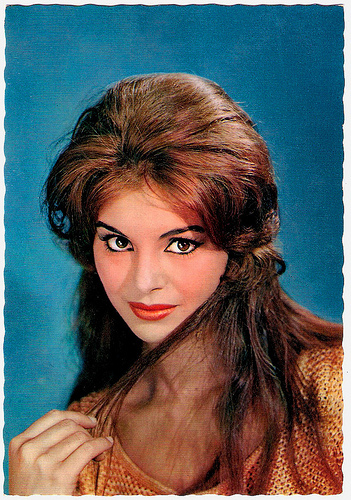
French postcard by E.D.U.G., no. 136. Photo: Sam Lévin.
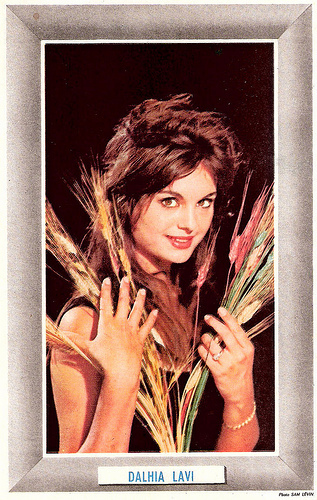
French postcard by St. Anne, Marseille. Photo: Sam Lévin.
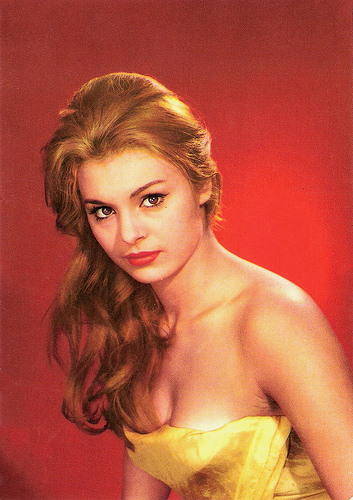
French postcard by Editions P.I., Paris, no. 1061. Photo: Sam Lévin.
Ravishing, Raven-haired Beauty
Daliah Lavi was born Daliah Lewinbukh (Levenbuch) in Shavei Zion, near the harbor city of Haifa in British Mandate of Palestine (now Israel) in 1942. She was the daughter of a German mother and a Russian father.
Kirk Douglas reportedly ‘discovered’ Daliah. He was making a film in Israel in 1952, when he met the Lewinbukhs. It was Daliah's tenth birthday and the family celebrated a party, where Douglas and the film crew were invited. As a birthday present, Douglas gave little Daliah a ballet dress, and two years later he arranged a scholarship for her to study ballet at the Royal Opera house in Stockholm.
In Sweden she also made her film debut in the August Strindberg adaptation Hemsöborna/The People of Hemso (Arne Mattsson, 1955). That year Lavi abruptly halted her beginning career and returned to Israel. According to some sources she had to give up ballet on account of her low blood pressure. Other sources write that she returned to Israel because of the death of her father.
The information on IMDb , AllMovie and German Wikipedia that she served in the Israeli Army is according to Henrik Hemlin at Mario Bava Tripod : “a false but persistent rumor”. In Israel the ravishing, raven-haired beauty began to work as a model.
In 1960, her film career really took off, when she played the lead role in the German-Israeli adventure film Brennender Sand/Blazing Sand (Raphael Nussbaum, 1960). That year she also costarred with Jean-Pierre Cassel in Candide ou l'optimisme au XXe siècle/Candide (Norbert Carbonnaux, 1960), a French comedy based on the classic novel Candide by Voltaire, but set in the World War II era.
The following years she appeared in several European films. Fluent in many languages, she acted in German, French, Italian, Spanish and English-language films. In Two Weeks in Another Town (Vincente Minnelli, 1962) she played alongside her old friend Kirk Douglas. For her part she was nominated for a Golden Globe.
Also notable was the Gothic horror film La Frusta e il corpo/The Whip and the Body (Mario Bava, 1963) with Christopher Lee . Jay Fenton writes at IMDb : “It is certainly one of the most brilliantly bizarre horror films ever made. Directed by cult icon Mario Bava, Italy's finest cinematographer (if not one of their finest directors), it rises as far above an S & M fantasy as can be imagined. It was censored in every country in the world for its sexual violence (...) Even now it remains a profoundly misunderstood film and should be seen in a theater in its complete form instead of on video.”
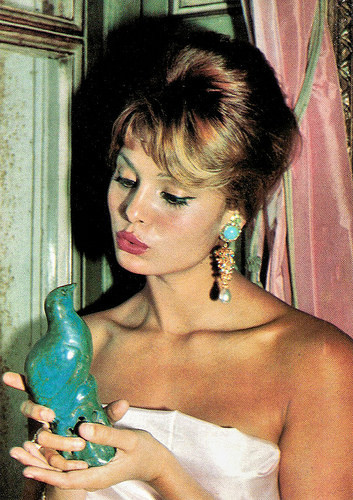
Spanish postcard by Postal Oscarcolor, no. 368.
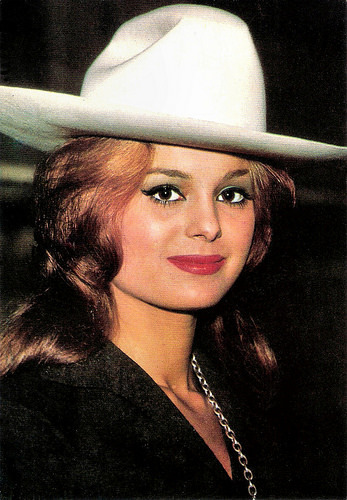
Spanish postcard by Postal Oscarcolor, no. 545.
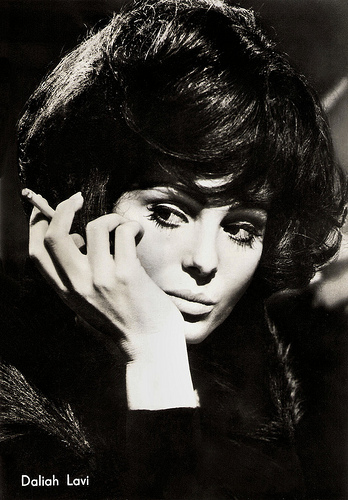
Big East-German card by VEB Progress Film-Vertrieb postcard, Berlin, no. 473, 1973. Photo: publicity still for Ten Little Indians (George Pollock, 1965).
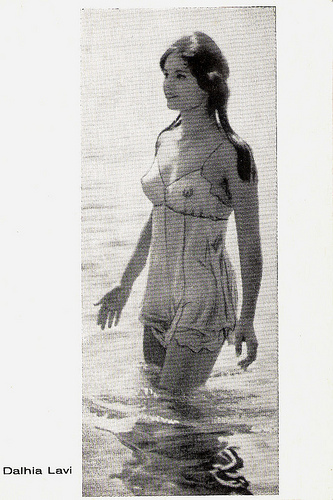
Vintage card.
Thigh-high Go-go Boots
Decked out in tight mini-skirts, thigh-high go-go boots and a helmet of black hair, Daliah Lavi fit in perfectly with the times. She became one of the swingers of the psychedelic 1960s. She reached a peak with her role of The Girl in Lord Jim (Richard Brooks, 1965). Hal Erickson writes at AllMovie : “Despite the impressive star lineup of (Peter) O'Toole, (Eli) Wallach, Jack Hawkins , Curt Jurgens and Paul Lukas , most press coverage went to leggy leading lady Daliah Lavi - including the 1964 Saturday Evening Post article about the making of Lord Jim, written by Richard Brooks himself.”
Hollywood noticed her, and she became one of its many sexy foreign imports at the time. Think also: Elke Sommer , Ewa Aulin, Senta Berger , Rosanna Schiaffino , Sylva Koscina , Barbara Bouchet, and of course Ursula Andress .
Lavi appeared in the first Matt Helm film The Silencers (Phil Karlson, 1966) opposite Dean Martin. Next she played a Russian princess in the spy spoof The Spy with a Cold Nose (Daniel Petrie, 1966) opposite Laurence Harvey . However, her most famous role is probably as 'The Detainer/007' in the James Bond parody Casino Royale (John Huston, a.o., 1967).
But when the 1960s ended, her film career also went in decline. Her last film was the very mediocre Catlow (Sam Wanamaker, 1971) with Yul Brynner .
In the meantime Lavi had started a new, equally successful career as a Schlager singer. In 1969, Israeli musical star Topol had invited her to sing some Hebrew songs in his BBC show. It resulted in a contract with Festival Records in the UK, but her record career took really off when she was contracted by the German Polydor label. Oh, wann kommst du? (Oh, when will you come?) in 1970 and Willst du mit mihr geh'n? (Do You Want To go with me?) became Top 10 hits in the German charts.
In 1971, she even was the most successful female singer in Germany, and she won an Otto, a major prize awarded by the German pop music magazine Bravo. Daliah kept turning out records until the early 1990s, even though her later releases fared less well in the charts.
She incidentally appeared on German television in dramatic roles, such as in the comedy Mrs. Harris und der Heiratsschwindler/Mrs Harris and The Marriage Swindlers (Franz Josef Gottlieb, 1991) featuring Inge Meysel, and in the series Duell zu dritt/Duel for Three (Peter Sämann, 1997).
In 2009 she made a surprise come-back in the German charts with the album C'est la vie - so ist das Leben (That’s Life) and the 66 year old diva went on a successful farewell tour along the German theatres. Daliah Lavi lived in the US with her fourth husband, businessman Charles Gans.
Daliah Lavi died of natural causes at her home in Asheville, US. She was 74, and had three sons, Rouben, Alexander and Stephen Gans, and a daughter, Kathy Rothman.
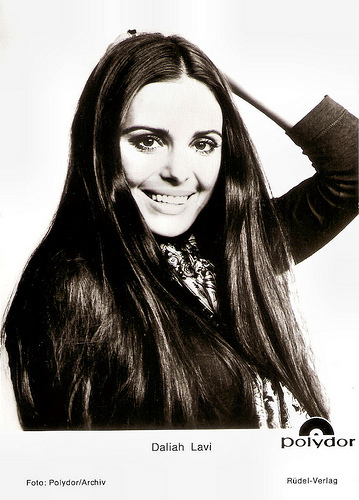
German postcard by Franz Josef Rüdel, Hamburg. Photo: Polydor.
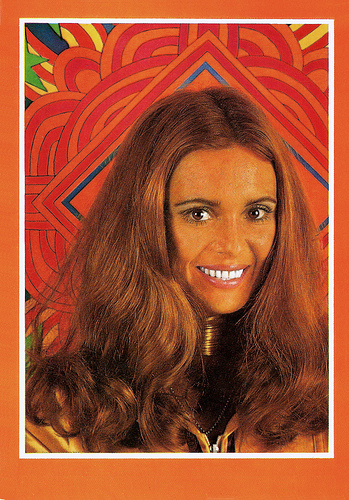
German promotion card by Polydor. Photo: Polydor / Wolfgang Hellemann.
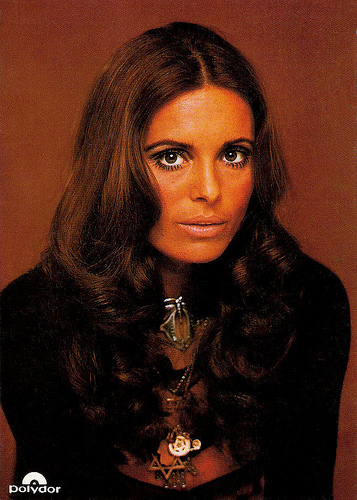
German postcard by Franz Josef Rüdel, Filmpostkartenverlag, Hamburg, no. F-58. Photo: Polydor.
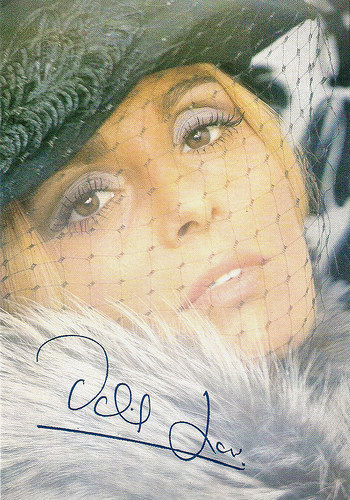
German promotion card by Polydor.
Sources: Henrik Hemlin (Mario Bava Tripod), (IMDb), Hal Erickson (AllMovie), Wikipedia (English and German) and .

French postcard by E.D.U.G., no. 136. Photo: Sam Lévin.

French postcard by St. Anne, Marseille. Photo: Sam Lévin.

French postcard by Editions P.I., Paris, no. 1061. Photo: Sam Lévin.
Ravishing, Raven-haired Beauty
Daliah Lavi was born Daliah Lewinbukh (Levenbuch) in Shavei Zion, near the harbor city of Haifa in British Mandate of Palestine (now Israel) in 1942. She was the daughter of a German mother and a Russian father.
Kirk Douglas reportedly ‘discovered’ Daliah. He was making a film in Israel in 1952, when he met the Lewinbukhs. It was Daliah's tenth birthday and the family celebrated a party, where Douglas and the film crew were invited. As a birthday present, Douglas gave little Daliah a ballet dress, and two years later he arranged a scholarship for her to study ballet at the Royal Opera house in Stockholm.
In Sweden she also made her film debut in the August Strindberg adaptation Hemsöborna/The People of Hemso (Arne Mattsson, 1955). That year Lavi abruptly halted her beginning career and returned to Israel. According to some sources she had to give up ballet on account of her low blood pressure. Other sources write that she returned to Israel because of the death of her father.
The information on IMDb , AllMovie and German Wikipedia that she served in the Israeli Army is according to Henrik Hemlin at Mario Bava Tripod : “a false but persistent rumor”. In Israel the ravishing, raven-haired beauty began to work as a model.
In 1960, her film career really took off, when she played the lead role in the German-Israeli adventure film Brennender Sand/Blazing Sand (Raphael Nussbaum, 1960). That year she also costarred with Jean-Pierre Cassel in Candide ou l'optimisme au XXe siècle/Candide (Norbert Carbonnaux, 1960), a French comedy based on the classic novel Candide by Voltaire, but set in the World War II era.
The following years she appeared in several European films. Fluent in many languages, she acted in German, French, Italian, Spanish and English-language films. In Two Weeks in Another Town (Vincente Minnelli, 1962) she played alongside her old friend Kirk Douglas. For her part she was nominated for a Golden Globe.
Also notable was the Gothic horror film La Frusta e il corpo/The Whip and the Body (Mario Bava, 1963) with Christopher Lee . Jay Fenton writes at IMDb : “It is certainly one of the most brilliantly bizarre horror films ever made. Directed by cult icon Mario Bava, Italy's finest cinematographer (if not one of their finest directors), it rises as far above an S & M fantasy as can be imagined. It was censored in every country in the world for its sexual violence (...) Even now it remains a profoundly misunderstood film and should be seen in a theater in its complete form instead of on video.”

Spanish postcard by Postal Oscarcolor, no. 368.

Spanish postcard by Postal Oscarcolor, no. 545.

Big East-German card by VEB Progress Film-Vertrieb postcard, Berlin, no. 473, 1973. Photo: publicity still for Ten Little Indians (George Pollock, 1965).

Vintage card.
Thigh-high Go-go Boots
Decked out in tight mini-skirts, thigh-high go-go boots and a helmet of black hair, Daliah Lavi fit in perfectly with the times. She became one of the swingers of the psychedelic 1960s. She reached a peak with her role of The Girl in Lord Jim (Richard Brooks, 1965). Hal Erickson writes at AllMovie : “Despite the impressive star lineup of (Peter) O'Toole, (Eli) Wallach, Jack Hawkins , Curt Jurgens and Paul Lukas , most press coverage went to leggy leading lady Daliah Lavi - including the 1964 Saturday Evening Post article about the making of Lord Jim, written by Richard Brooks himself.”
Hollywood noticed her, and she became one of its many sexy foreign imports at the time. Think also: Elke Sommer , Ewa Aulin, Senta Berger , Rosanna Schiaffino , Sylva Koscina , Barbara Bouchet, and of course Ursula Andress .
Lavi appeared in the first Matt Helm film The Silencers (Phil Karlson, 1966) opposite Dean Martin. Next she played a Russian princess in the spy spoof The Spy with a Cold Nose (Daniel Petrie, 1966) opposite Laurence Harvey . However, her most famous role is probably as 'The Detainer/007' in the James Bond parody Casino Royale (John Huston, a.o., 1967).
But when the 1960s ended, her film career also went in decline. Her last film was the very mediocre Catlow (Sam Wanamaker, 1971) with Yul Brynner .
In the meantime Lavi had started a new, equally successful career as a Schlager singer. In 1969, Israeli musical star Topol had invited her to sing some Hebrew songs in his BBC show. It resulted in a contract with Festival Records in the UK, but her record career took really off when she was contracted by the German Polydor label. Oh, wann kommst du? (Oh, when will you come?) in 1970 and Willst du mit mihr geh'n? (Do You Want To go with me?) became Top 10 hits in the German charts.
In 1971, she even was the most successful female singer in Germany, and she won an Otto, a major prize awarded by the German pop music magazine Bravo. Daliah kept turning out records until the early 1990s, even though her later releases fared less well in the charts.
She incidentally appeared on German television in dramatic roles, such as in the comedy Mrs. Harris und der Heiratsschwindler/Mrs Harris and The Marriage Swindlers (Franz Josef Gottlieb, 1991) featuring Inge Meysel, and in the series Duell zu dritt/Duel for Three (Peter Sämann, 1997).
In 2009 she made a surprise come-back in the German charts with the album C'est la vie - so ist das Leben (That’s Life) and the 66 year old diva went on a successful farewell tour along the German theatres. Daliah Lavi lived in the US with her fourth husband, businessman Charles Gans.
Daliah Lavi died of natural causes at her home in Asheville, US. She was 74, and had three sons, Rouben, Alexander and Stephen Gans, and a daughter, Kathy Rothman.

German postcard by Franz Josef Rüdel, Hamburg. Photo: Polydor.

German promotion card by Polydor. Photo: Polydor / Wolfgang Hellemann.

German postcard by Franz Josef Rüdel, Filmpostkartenverlag, Hamburg, no. F-58. Photo: Polydor.

German promotion card by Polydor.
Sources: Henrik Hemlin (Mario Bava Tripod), (IMDb), Hal Erickson (AllMovie), Wikipedia (English and German) and .
Published on May 04, 2017 22:00
May 3, 2017
Das Herz der Königin (1940)
The German historical film Das Herz der Königin/The Heart of a Queen (Carl Froehlich, 1940), stars Swedish diva Zarah Leander as Mary Stuart Queen of Scots and Nazi heartthrob Willy Birgel as Lord Bothwell. The film was intended as anti-English propaganda in the context of the Second World War, presenting English Queen Elizabeth I as a cold, scheming queen striving for domination, while the Scottish Mary is presented as the Queen of Hearts.
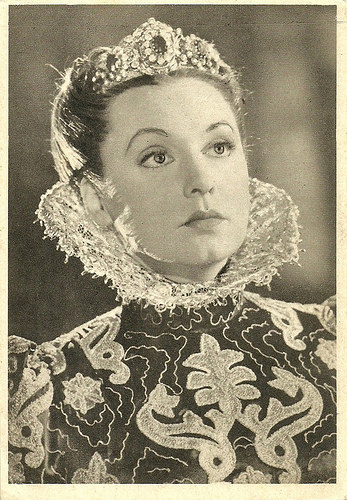
German postcard by Das Illustrierte Blatt, Frankfurter Illustrierte. Photo: Ufa. Publicity still for Das Herz der Königin (Carl Froehlich, 1940), starring Zarah Leander as Mary, Queen of Scots.
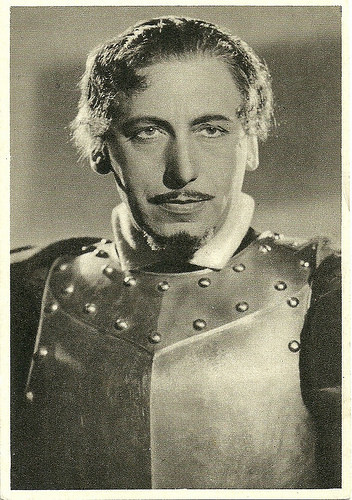
German postcard by Das Illustrierte Blatt, Frankfurter Illustrierte. Photo: Ufa. Willy Birgel in Das Herz der Königin (Carl Froehlich, 1940).
Waiting for the judgementOriginally, the cast & crew of Das Herz der Königin were signed on to film a biopic on Catherine the Great of Russia. Zarah Leander would star in the title role, but once war broke out between Germany and the Soviet Union, Joseph Goebbels ordered the film scrapped and the production team was told to make a film about Mary Stuart instead.
In Das Herz der Königin, Mary Stuart ( Zarah Leander ) is presented as the Queen of Hearts, whose actions are only led by emotions and indirectly cause her the loss of the men around her and herself too. Not only Elzabeth, but the Scottish men and women in Mary's life make her life misery as well: the evil, brutal half-brother Jacob, the coward Bothwell, the vengeful Gordon.
Scottish nobility is no positive alternative to the English court, the film suggests. This deviates from other anti-British propaganda films of the Third Reich in which e.g. the Irish or the Australians are presented as the positive, honest alternative.
The film is mostly told in flashback. It starts with Mary Stuart, Queen of Scots, held prisoner in the Tower in London and waiting for the judgement of her court case. Soon she finds out that she is sentenced to death by the scaffold on the next day. Breaking down, she recalls the events leading to her imminent death.
The flashback starts with young Mary arriving from France to Scotland, as the lawful Queen of Scots, only to encounter a strong opposition by all parties around her. First of all is her half-brother Jacob Stuart (Walther Suessenguth), who is the former Scottish ruler. He asserts that a woman is incapable of ruling the 'rough' and 'male' land of Scotland.
Also the lords, headed by Lord Bothwell ( Willy Birgel ), face Mary Stuart critically. Moreover, upon her arrival Mary faces an assassination attempt by Johanna (Jean) Gordon ( Lotte Koch ), whose clan is at feud with the Stuarts for ages. Her Privy Council refuses to show up, apart from Jacob Stuart, who tears up the document presented for his signature. When the Queen is alone again, Bothwell arrives and confesses that he had fallen in love with her. Mary orders him arrested for insulting the Queen, even though impressed by him.
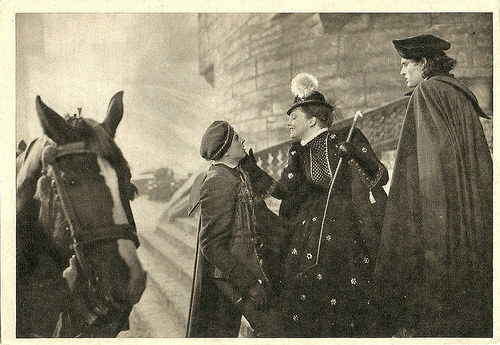
German postcard by Das Illustrierte Blatt, Frankfurter Illustrierte. Photo: Ufa. Publicity still for Das Herz der Königin (Carl Froehlich, 1940), starring Zarah Leander (standing in the middle), with on the right is Friedrich/Enrico Benfer as David Riccio, and on the left Will Quadflieg as Page Olivier.
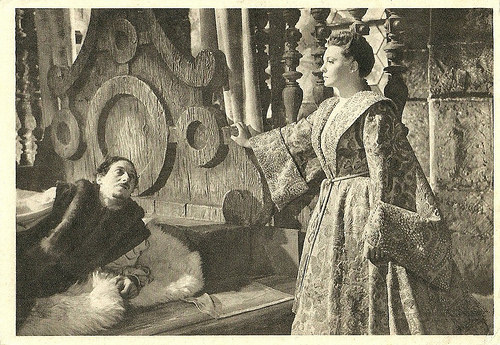
German postcard by Das Illustrierte Blatt, Frankfurter Illustrierte. Photo: Ufa. Publicity still for Das Herz der Königin (Carl Froehlich, 1940), with Zarah Leander and Willy Birgel .
Motivated by revenge and lust for power
Meanwhile, Queen Elizabeth I (Maria Koppenhofer), angered by the competition of the new Scottish queen and even suspecting a threat to her right to the English throne, sends her confidant Lord Henry Darnley ( Axel von Ambesser ), a Scottish-born dandy to Scotland to spy for her and to raise the population against Mary.
Yet, Darnley himself falls in love with Mary and leads her to Bothwell's Castle, where the Scottish lords plot the Queen's deposition. Mary ventures alone into the meeting. She is imprisoned, but released the next day on condition she will marry a Scot. Mary chooses lord Bothwell, whom she believes to be still in captivity, but who has fled with Jean Gordon and has married her. The two of them raise an army to overthrow Mary – motivated by revenge and lust for power.
The Queen is forced to marry Darnley, but becomes involved with Italian singer David Riccio ( Enrico Benfer ). Eventually, she gives birth to a boy child, James - the future King James I. A troupe of travelling actors stages a play, openly hinting that Riccio is the Queen's lover and might be the father of her child, so the insulted and angered Darnley has Riccio assassinated.
At this time Bothwells' army appears, which The Queen allows to enter his own Castle and temporarily take over power in the land "for the Queen's own protection". Lord Darnley has meanwhile fallen ill with smallpox. On advice of the true stern Scottish Lord Bothwell, now her lover, Mary sends her ill husband to Edinburgh, where he dies in an explosion at his home.
Queen Elisabeth sends an army to Scotland to release Mary from the power of Bothwell and to offer to her refuge in England - actually a trap meant to imprison Mary and keep her away from the throne of Scotland. Meanwhile, Mary has married Bothwell, who has separated from Gordon, but the wedding is interrupted when the English army appears under the guidance of Jacob Stuart. He presents secret love letters which Mary had sent to Bothwell while still married to her previous husband.
Olivier ( Will Quadflieg ), the Queen's page, is killed while trying to hide the letters. Bothwell is faced with the choice of standing by Mary and dying, or denying her. He turns away from her, but the treacherous Jacob still sentences him to death. When Jacob takes from his half-sister her only child James, to protect him against Elizabeth, Mary accepts the offer of the English Queen and goes into exile in England, which leads to her imprisonment and death.
The frame story from the beginning resumes. Mary makes peace with dying and pledges her undying love to her ladies-in-waiting, the Scottish people, and the men she loved and lost. The next morning Mary, in a stunning bejewelled gown, is led to the scaffold and kneels down in prayer as she awaits the sharp hatchet to fall.
Das Herz der Königin became a failure in its time and also today counts as one of the weakest of Zarah Leander 's films.
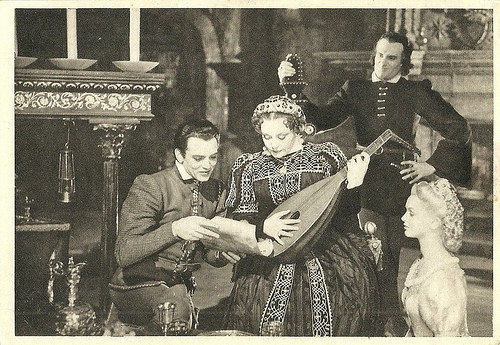
German postcard by Das Illustrierte Blatt, Frankfurter Illustrierte. Photo: Ufa. Publicity still for Das Herz der Königin (Carl Froehlich, 1940), with from left to right Will Quadflieg (Page Olivier), Zarah Leander (Mary Queen of Scots), Enrico Benfer (David Riccio), and Anneliese von Eschstruth.
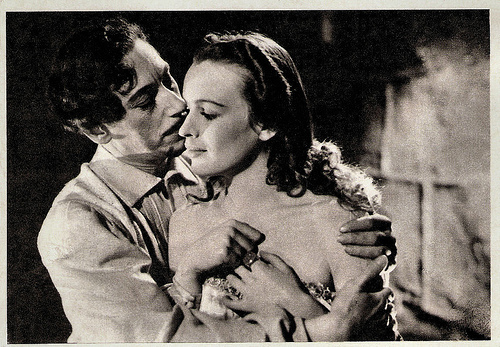
German postcard by Das Illustrierte Blatt. Photo: Ufa / Lindner. Publicity still for Das Herz der Königin/The Heart of a Queen (Carl Froelich, 1940) with Willy Birgel and Lotte Koch .
Sources: Wikipedia and IMDb.

German postcard by Das Illustrierte Blatt, Frankfurter Illustrierte. Photo: Ufa. Publicity still for Das Herz der Königin (Carl Froehlich, 1940), starring Zarah Leander as Mary, Queen of Scots.

German postcard by Das Illustrierte Blatt, Frankfurter Illustrierte. Photo: Ufa. Willy Birgel in Das Herz der Königin (Carl Froehlich, 1940).
Waiting for the judgementOriginally, the cast & crew of Das Herz der Königin were signed on to film a biopic on Catherine the Great of Russia. Zarah Leander would star in the title role, but once war broke out between Germany and the Soviet Union, Joseph Goebbels ordered the film scrapped and the production team was told to make a film about Mary Stuart instead.
In Das Herz der Königin, Mary Stuart ( Zarah Leander ) is presented as the Queen of Hearts, whose actions are only led by emotions and indirectly cause her the loss of the men around her and herself too. Not only Elzabeth, but the Scottish men and women in Mary's life make her life misery as well: the evil, brutal half-brother Jacob, the coward Bothwell, the vengeful Gordon.
Scottish nobility is no positive alternative to the English court, the film suggests. This deviates from other anti-British propaganda films of the Third Reich in which e.g. the Irish or the Australians are presented as the positive, honest alternative.
The film is mostly told in flashback. It starts with Mary Stuart, Queen of Scots, held prisoner in the Tower in London and waiting for the judgement of her court case. Soon she finds out that she is sentenced to death by the scaffold on the next day. Breaking down, she recalls the events leading to her imminent death.
The flashback starts with young Mary arriving from France to Scotland, as the lawful Queen of Scots, only to encounter a strong opposition by all parties around her. First of all is her half-brother Jacob Stuart (Walther Suessenguth), who is the former Scottish ruler. He asserts that a woman is incapable of ruling the 'rough' and 'male' land of Scotland.
Also the lords, headed by Lord Bothwell ( Willy Birgel ), face Mary Stuart critically. Moreover, upon her arrival Mary faces an assassination attempt by Johanna (Jean) Gordon ( Lotte Koch ), whose clan is at feud with the Stuarts for ages. Her Privy Council refuses to show up, apart from Jacob Stuart, who tears up the document presented for his signature. When the Queen is alone again, Bothwell arrives and confesses that he had fallen in love with her. Mary orders him arrested for insulting the Queen, even though impressed by him.

German postcard by Das Illustrierte Blatt, Frankfurter Illustrierte. Photo: Ufa. Publicity still for Das Herz der Königin (Carl Froehlich, 1940), starring Zarah Leander (standing in the middle), with on the right is Friedrich/Enrico Benfer as David Riccio, and on the left Will Quadflieg as Page Olivier.

German postcard by Das Illustrierte Blatt, Frankfurter Illustrierte. Photo: Ufa. Publicity still for Das Herz der Königin (Carl Froehlich, 1940), with Zarah Leander and Willy Birgel .
Motivated by revenge and lust for power
Meanwhile, Queen Elizabeth I (Maria Koppenhofer), angered by the competition of the new Scottish queen and even suspecting a threat to her right to the English throne, sends her confidant Lord Henry Darnley ( Axel von Ambesser ), a Scottish-born dandy to Scotland to spy for her and to raise the population against Mary.
Yet, Darnley himself falls in love with Mary and leads her to Bothwell's Castle, where the Scottish lords plot the Queen's deposition. Mary ventures alone into the meeting. She is imprisoned, but released the next day on condition she will marry a Scot. Mary chooses lord Bothwell, whom she believes to be still in captivity, but who has fled with Jean Gordon and has married her. The two of them raise an army to overthrow Mary – motivated by revenge and lust for power.
The Queen is forced to marry Darnley, but becomes involved with Italian singer David Riccio ( Enrico Benfer ). Eventually, she gives birth to a boy child, James - the future King James I. A troupe of travelling actors stages a play, openly hinting that Riccio is the Queen's lover and might be the father of her child, so the insulted and angered Darnley has Riccio assassinated.
At this time Bothwells' army appears, which The Queen allows to enter his own Castle and temporarily take over power in the land "for the Queen's own protection". Lord Darnley has meanwhile fallen ill with smallpox. On advice of the true stern Scottish Lord Bothwell, now her lover, Mary sends her ill husband to Edinburgh, where he dies in an explosion at his home.
Queen Elisabeth sends an army to Scotland to release Mary from the power of Bothwell and to offer to her refuge in England - actually a trap meant to imprison Mary and keep her away from the throne of Scotland. Meanwhile, Mary has married Bothwell, who has separated from Gordon, but the wedding is interrupted when the English army appears under the guidance of Jacob Stuart. He presents secret love letters which Mary had sent to Bothwell while still married to her previous husband.
Olivier ( Will Quadflieg ), the Queen's page, is killed while trying to hide the letters. Bothwell is faced with the choice of standing by Mary and dying, or denying her. He turns away from her, but the treacherous Jacob still sentences him to death. When Jacob takes from his half-sister her only child James, to protect him against Elizabeth, Mary accepts the offer of the English Queen and goes into exile in England, which leads to her imprisonment and death.
The frame story from the beginning resumes. Mary makes peace with dying and pledges her undying love to her ladies-in-waiting, the Scottish people, and the men she loved and lost. The next morning Mary, in a stunning bejewelled gown, is led to the scaffold and kneels down in prayer as she awaits the sharp hatchet to fall.
Das Herz der Königin became a failure in its time and also today counts as one of the weakest of Zarah Leander 's films.

German postcard by Das Illustrierte Blatt, Frankfurter Illustrierte. Photo: Ufa. Publicity still for Das Herz der Königin (Carl Froehlich, 1940), with from left to right Will Quadflieg (Page Olivier), Zarah Leander (Mary Queen of Scots), Enrico Benfer (David Riccio), and Anneliese von Eschstruth.

German postcard by Das Illustrierte Blatt. Photo: Ufa / Lindner. Publicity still for Das Herz der Königin/The Heart of a Queen (Carl Froelich, 1940) with Willy Birgel and Lotte Koch .
Sources: Wikipedia and IMDb.
Published on May 03, 2017 22:00
Paul van Yperen's Blog
- Paul van Yperen's profile
- 13 followers
Paul van Yperen isn't a Goodreads Author
(yet),
but they
do have a blog,
so here are some recent posts imported from
their feed.



